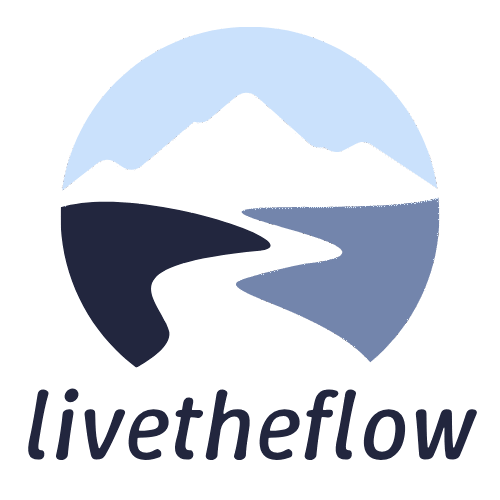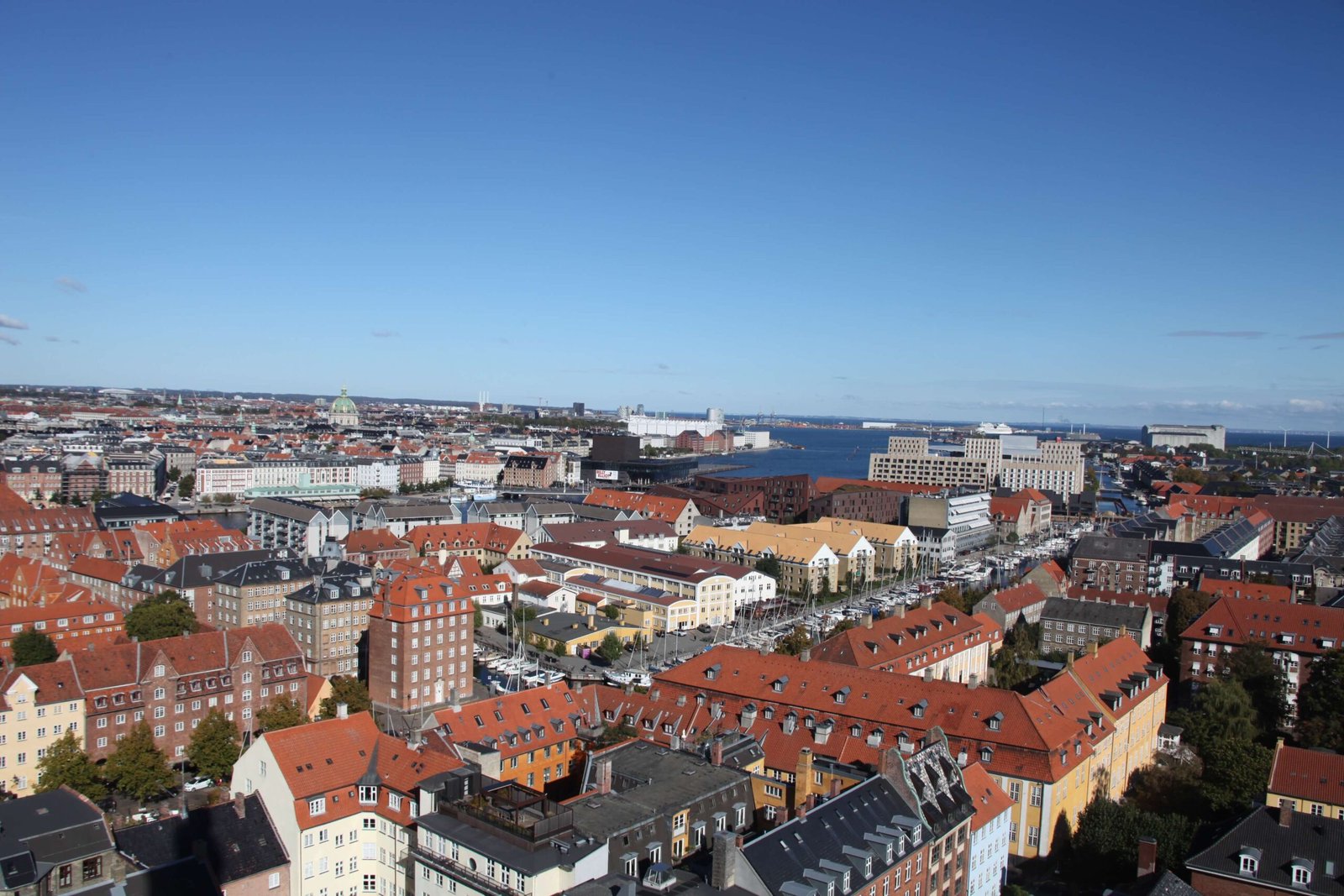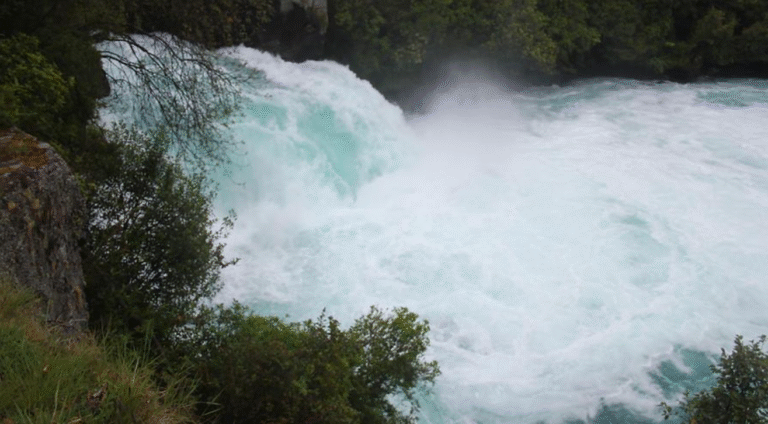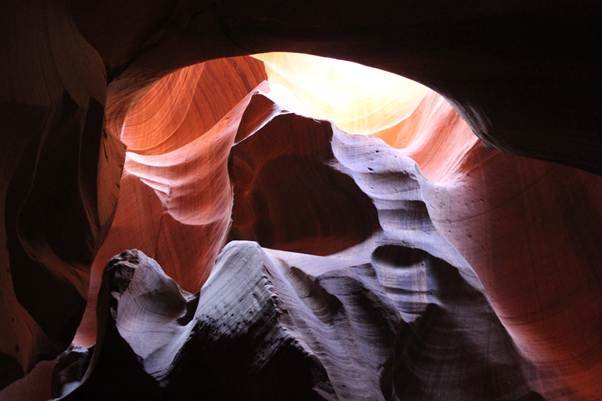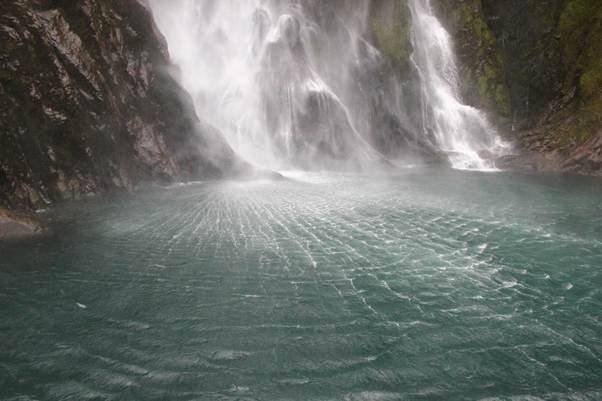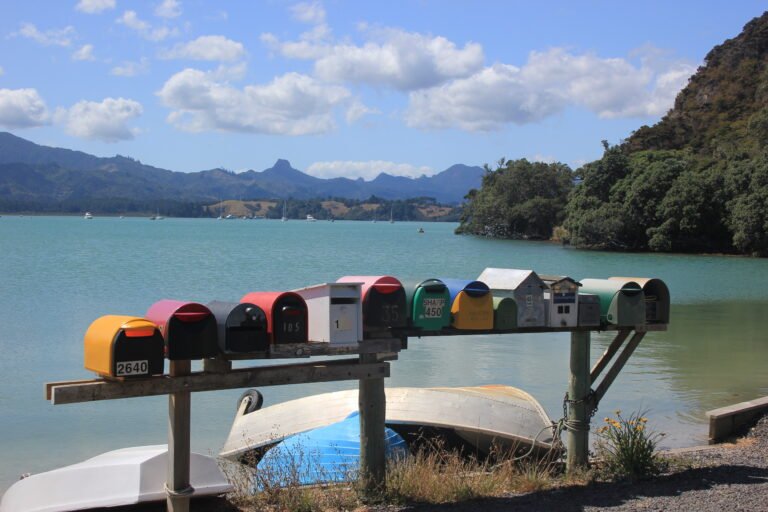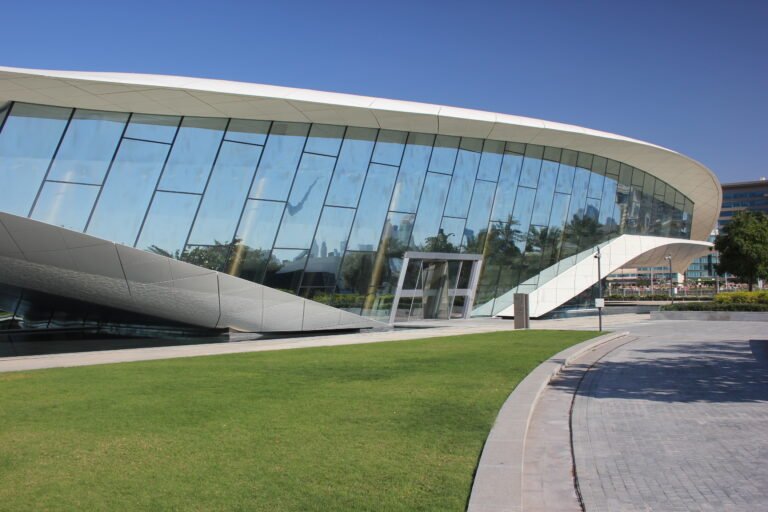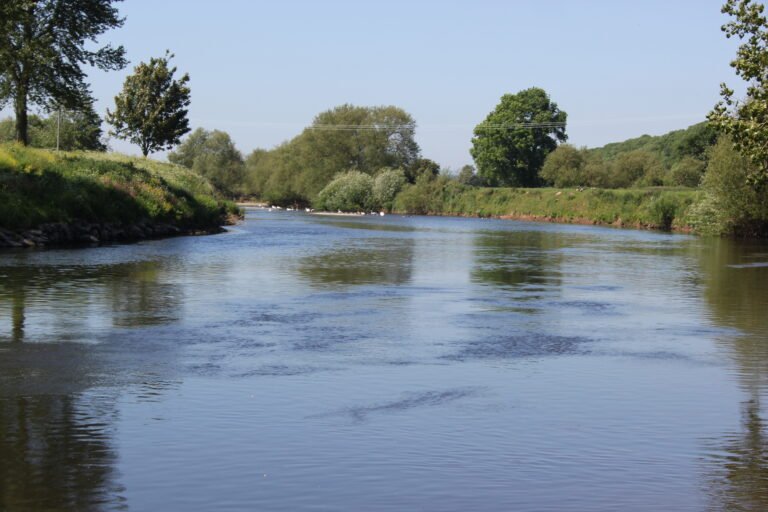Scandi24
AN O.A.P. ADVENTURE as written at the time, September 2024. It was a fantastic three weeks, hugely worth having a go.
1. ALL SET TO GO
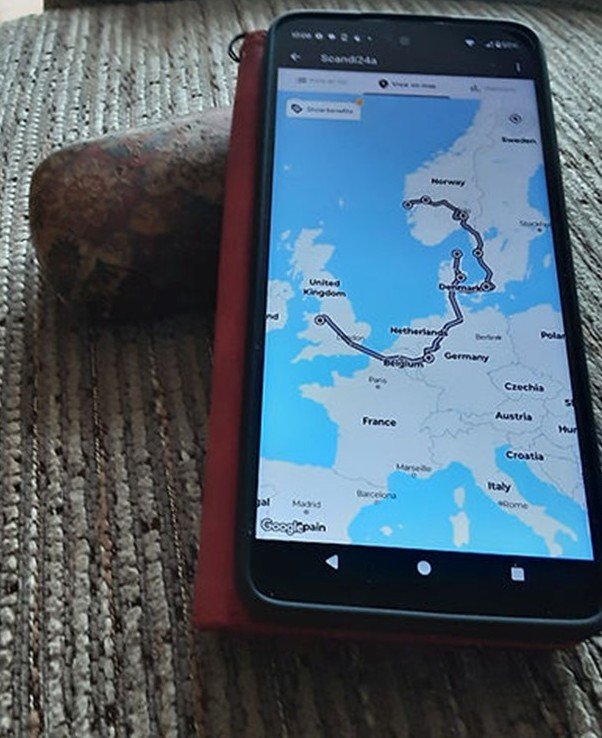
I am hoping to record a potentially crazy adventure we are about to start at the end of this week: Scandi24. It all depends on my failing memory of how to do things and the kit working! I’m optimistic.
Well into our 70’s we are going ‘inter-rail’: the thing that you do in your late teens and student days! At the least, we are on trend by using ‘green travel’, a tic-box accolade which should please some. We hope we can cope with the technology, QR codes, digital itinerary & tickets, etc: that all the planning holds together.
The plan is to go by train from Gobowen to Denmark. After a few days there we go to Bergen by Ferry. We shall explore a little of the Bergen area before returning via Oslo, Gothenburg and Copenhagen. We return early in October. We are nervous about it but soon we shall discover to what extent this ambition is inspired or deranged. Watch this space?!
2. ON THE MOVE: COLOGNE STOPOVER
It’s been a bit surreal: an idea to do something we have never done before; deciding to go for it, planning all the detail … and now it is happening.
We have an Inter-Rail pass for ten days of travel over three weeks. My hearing disability allows Jenni to travel free as my carer … she has over 50 years’ experience! The extra cost to go First Class was surprisingly modest… So that’s what we are doing.
Already, we are pleased with that decision. We got seats, space and comfort. Of the three trains we used on our first day, including Eurostar, the Avanti West Coast Chester to London journey was easily the best!
Eleven hours, including changeovers, took us from Gobowen via Chester, London and Brussels to Cologne, where we decided to break the trip.
An Internet comment warned that there’s not much to see here except “the cathedral, the cathedral, and the cathedral”. In a way that’s down to us. According to Wikipedia, the allies dropped 44,923.2 tons of bombs on the place, so precious little was left of this historic settlement on the Rhine used at least since Roman times.
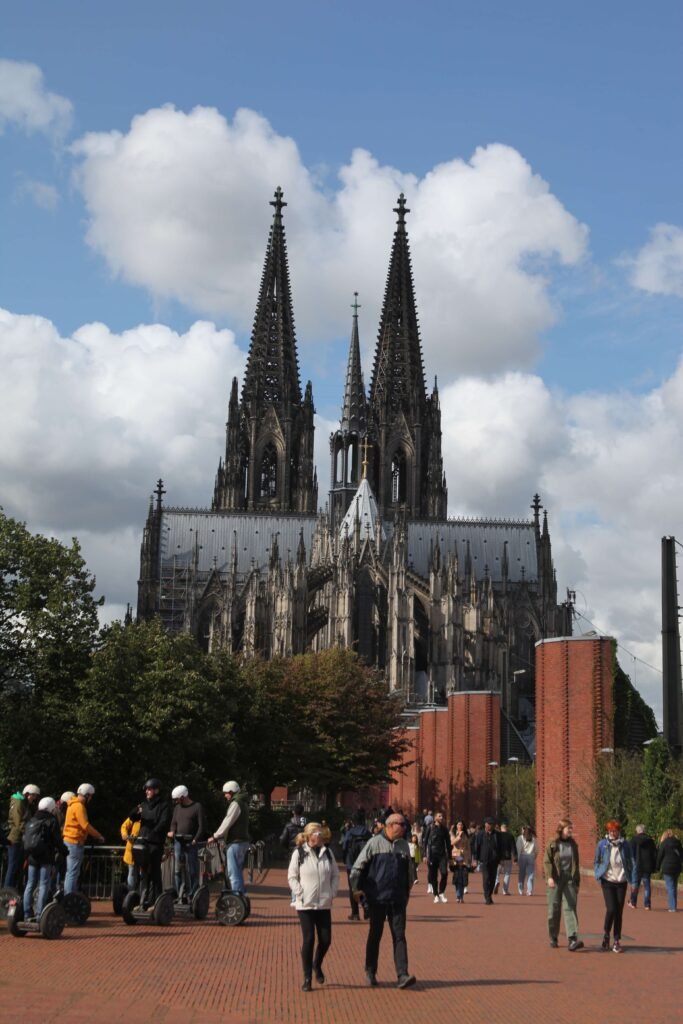
The Cathedral Church of St Peter dominates the city. Although started in the 13th Century, it was not completed till the 19th. It is huge: still the largest church facade in the world and the 3rd tallest of any church structure worldwide.
It has about 6 million visitors a year. I don’t know about the other 5,999,999 but, apart from being architecturally amazing, it does nothing for me. I have never quite worked out how this sort of edifice fits in with the Beatitudes and Jesus’s sermon on the Mount. Perhaps someone can explain?
We particularly enjoyed strolling by the river. Although it was Saturday, we saw a many large cargo barges: evidence of the continued industrial significance of the river. Probably because it was Saturday, there were about a dozen of the luxurious River Cruise barges most taking on new passengers for the week.

On the tourist tick box list is the Hohenzollernbrucke, the railway bridge to the station, which is right next to the cathedral. It is now famous for its love locks.

Yes, there are reckoned to be about 350,000 padlocks on the bridge!

One of the arguments for using railways is that, unlike airports, stations are in the centre. We are using hostels (private rooms not dorms) and our first was 400m from the station, 250m from the cathedral and adjacent to the main shopping streets. I liked the bubbles, which, with the river, attune with livetheflow themes! Next stop Denmark.
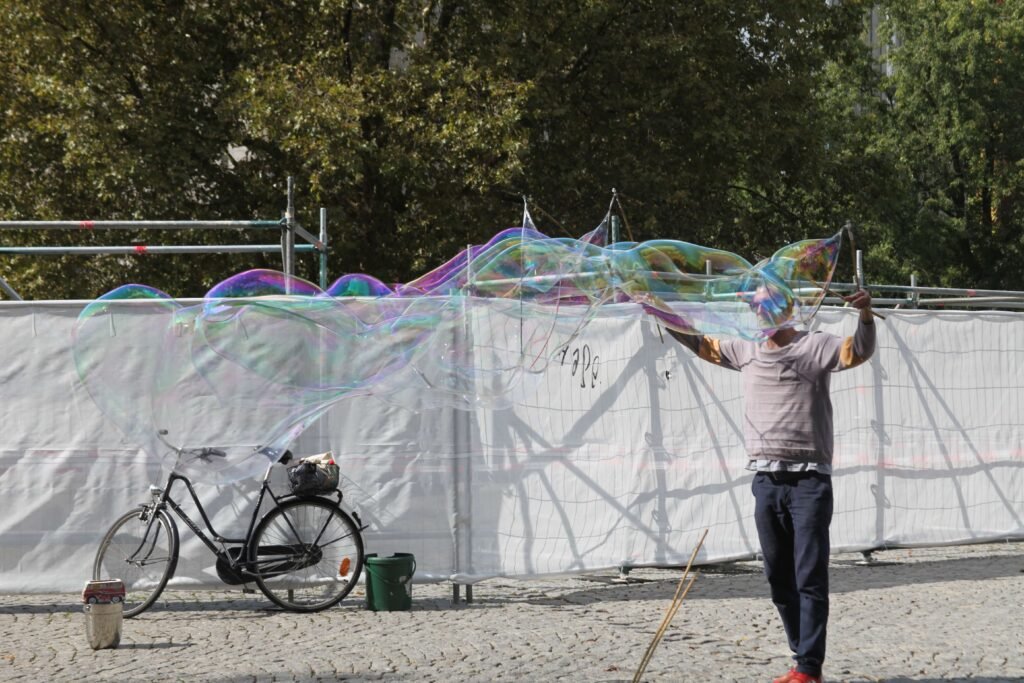
3. IT WOULD NOT HAPPEN ON A CRUISE!
Our spend on this 21-day tour is probably a touch more than the most basic 7-day Norwegian cruise from Southampton. If we had taken a cruise, there are a few things we would have been glad to avoid, but we think these are heavily outweighed by a great many experiences we would have missed on a cruise.
There are pluses to the processes involved in DIY travel. You do have to carry travel anxiety, will it work out, what happens if questions and more. There is nobody there to tell you what to do next and where to go. Sometimes it’s just foreign signs!
When we turned up at our hostel in Aarhus, after 12 hours on the move, we found reception deserted and everything locked. Our fellow travellers had all had emails for access to keys, but we hadn’t! This would definitely not happen on a cruise! Fortunately, after a bit of hassle, we were upgraded to a budget hotel at no extra cost for three nights.
Travel itself on InterRail is integral to the holiday experience. It is there to be enjoyed and savoured, not endured. First Class helps enormously! Even on a fast train, we get a feel for the places we pass through. Following our progress on Google Maps translates what we see into greater meaning. It is a different, but welcome, mindset and experience. Not ‘getting away from it all’ is probably not everyone’s choice for a holiday, but there is a richness and depth to being part of the everyday life of the places you visit.
We would heartily recommend Aarhus for a stopover. It is the second city of Denmark. I suspect, like all cities, it has its downtown areas, but what we saw was clean and well-ordered: an extremely pleasant city environment where bikes, pedestrians and public transport rule.
There is near-universal obedience to the pedestrian stop / go lights. A Brit expat told me he had even seen people obey them at 4 am when there were no vehicles or bikes in sight!
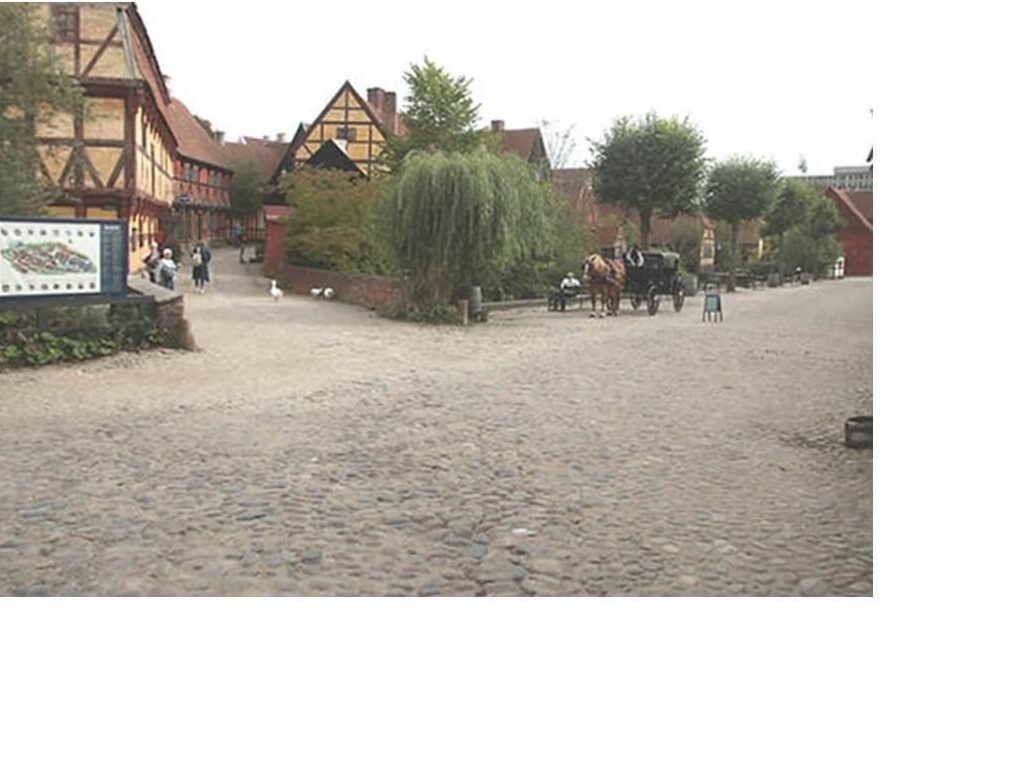
We enjoyed visiting the ‘Old Town Museum’, Den Gamle By, a combination of the Black Country Museum and Ironbridge. They started building it back in the 1920’s. Now it has different sets of buildings representing various eras in Danish history, right up to 2014. There’s a whole collection of mini museums of all sorts: from toys to bikes, and from bookbinding to a smithy. These are scattered around in the buildings. There’s also a museum dedicated to the history of Aarhus.

Another spectacle was Aros, their museum of art. It was all rectangular brick on the outside……

… and all curves inside.
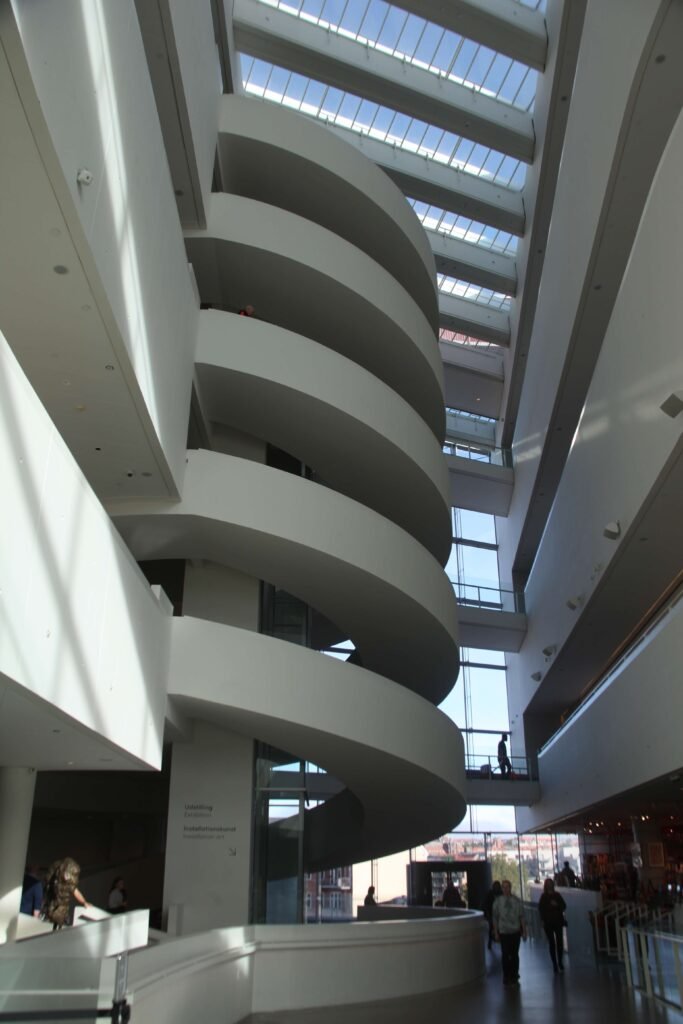
Literally, crowning it all, was the multicolour sky walk with spectacular views all round. One of those unforgettable experiences!

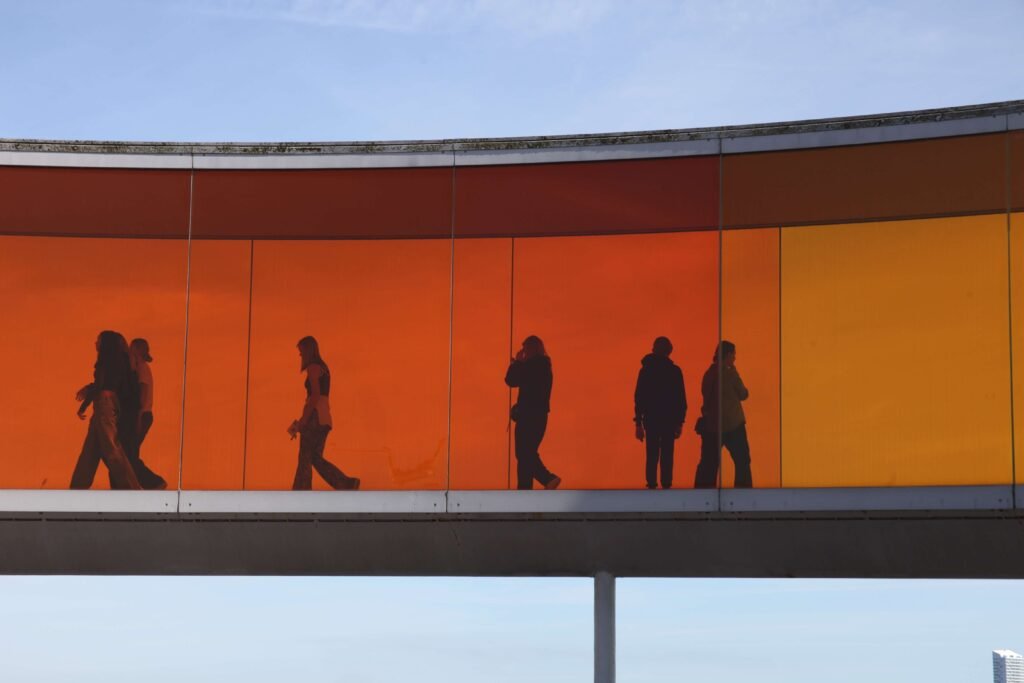
The warm Indian summer evenings were a huge boost to our holiday. We discovered Street Food on our second evening. It is best described as a run-down warehouse with a vast range of ethnic foods being sold from loads of individual food trailers. On two evenings, we picked up good mains courses for around £10. We dined in the convivial atmosphere outside. The experience added greatly to the charming atmosphere of the city.
Sad that we don’t eat outside more at home.
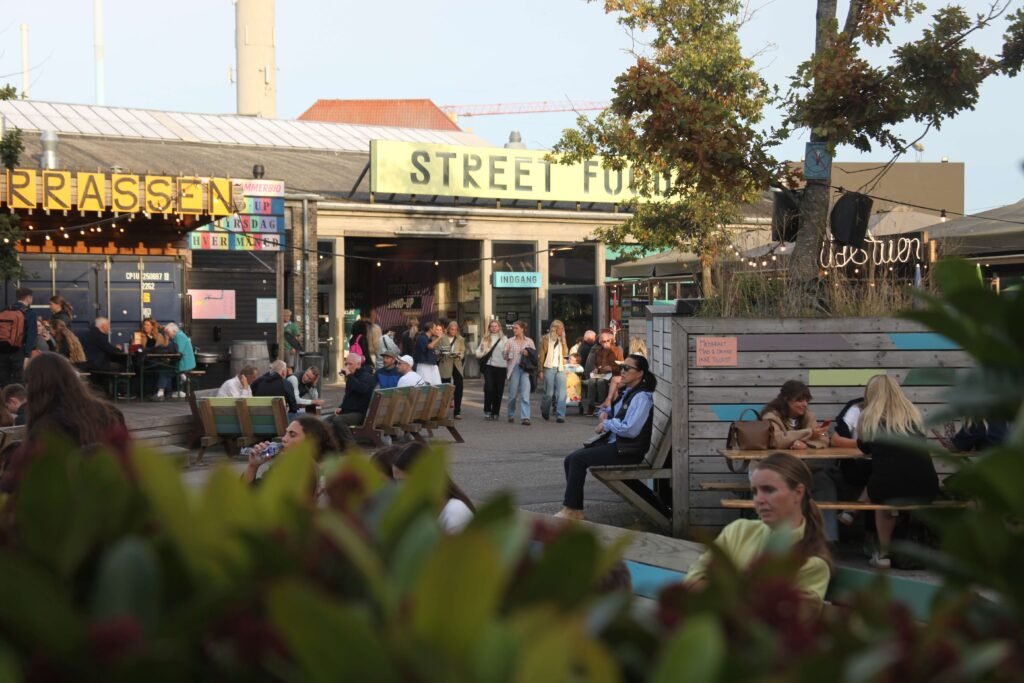
The Cathedral, next to our hotel, was very different architecturally to Cologne. Brick built it was painted white inside creating a refreshing experience quite different to the darkness of many stone cathedrals. Despite this it did not emanate spiritual warmth … my fault? There were one or two odd ‘Christian ‘ drawings around!
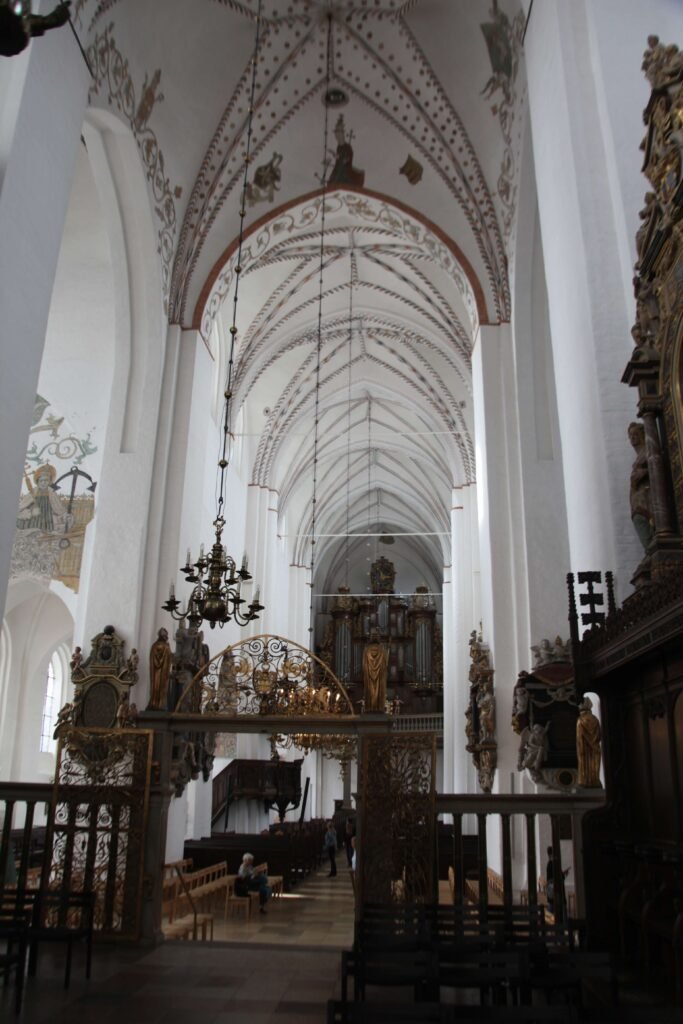
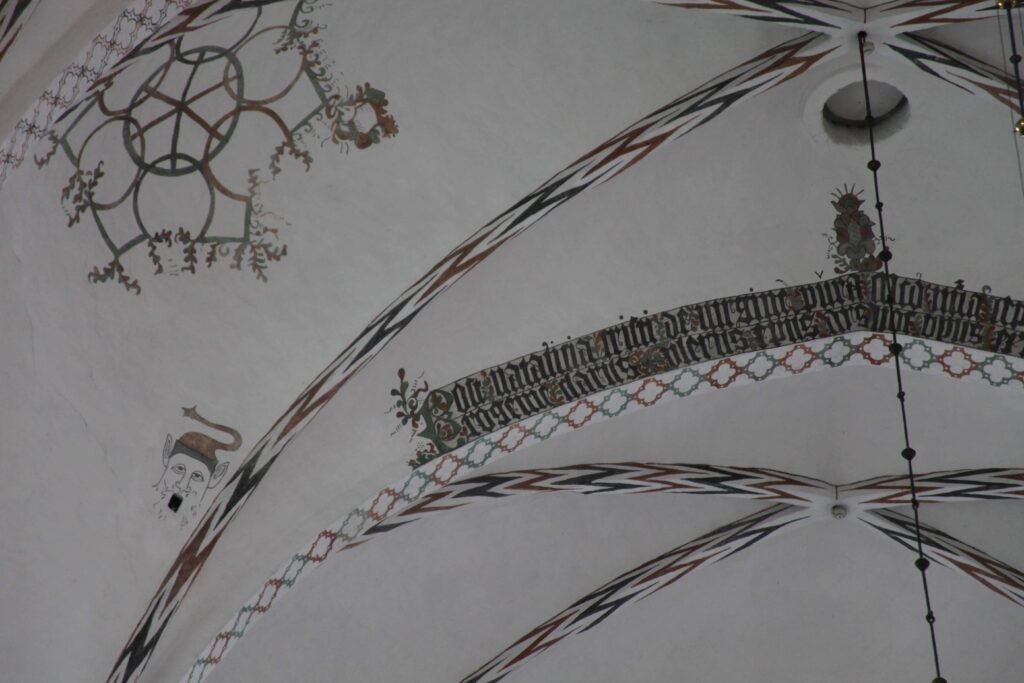
On the last evening I managed to find a pub, The Lion, showing Villa’s win in their first Champions League match. The Landlord was from Hereford. His mother is still living in Shrewsbury. A good evening to round of two good days.
We enjoyed a lot more .. but I have to end with the water installation by the waterfront. Kids just love it and I’m old enough to enjoy the second childhood!

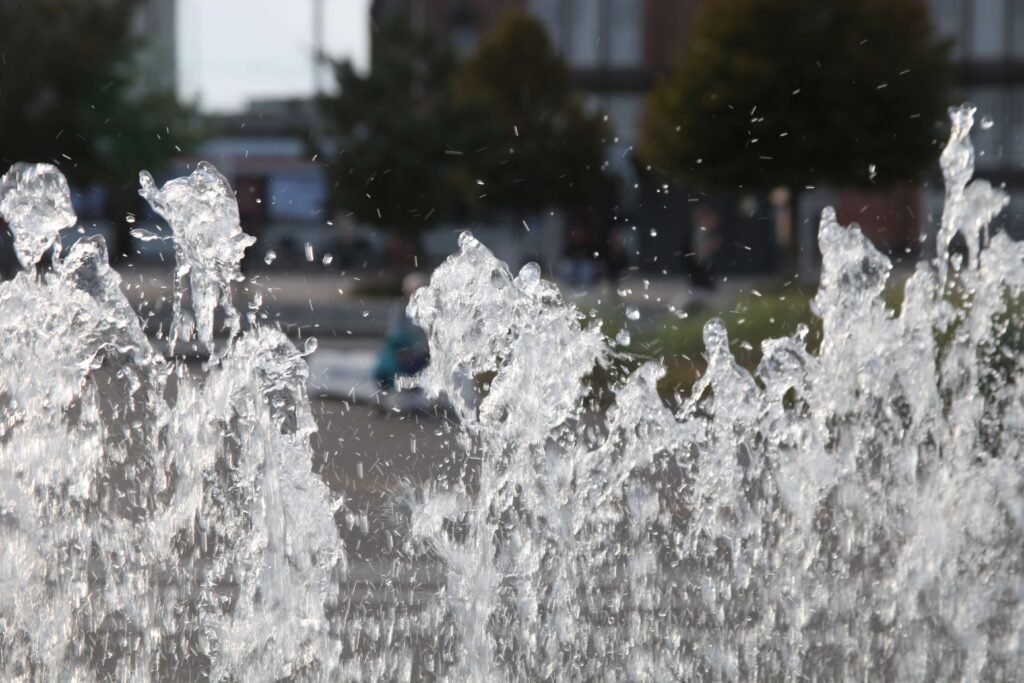
We have now left Denmark and are on our mini cruise… the ferry to Bergen. I have always wanted to see some Norwegian Fjords since my school day geography lessons, xx years ago!
Travelling the length of Denmark was interesting. Imagine a huge edition of Norfolk. The F’s abounded: lots of Flat land; Farms on an industrial scale with many huge Fields. There were many Forests, from small to large. Great tracts of Northern Denmark consisted of remote farms and few towns and villages. Free open space. I would have loved to explore the remote North West sand-lined coast
4. OUR MINI CRUISE – DENMARK TO NORWAY
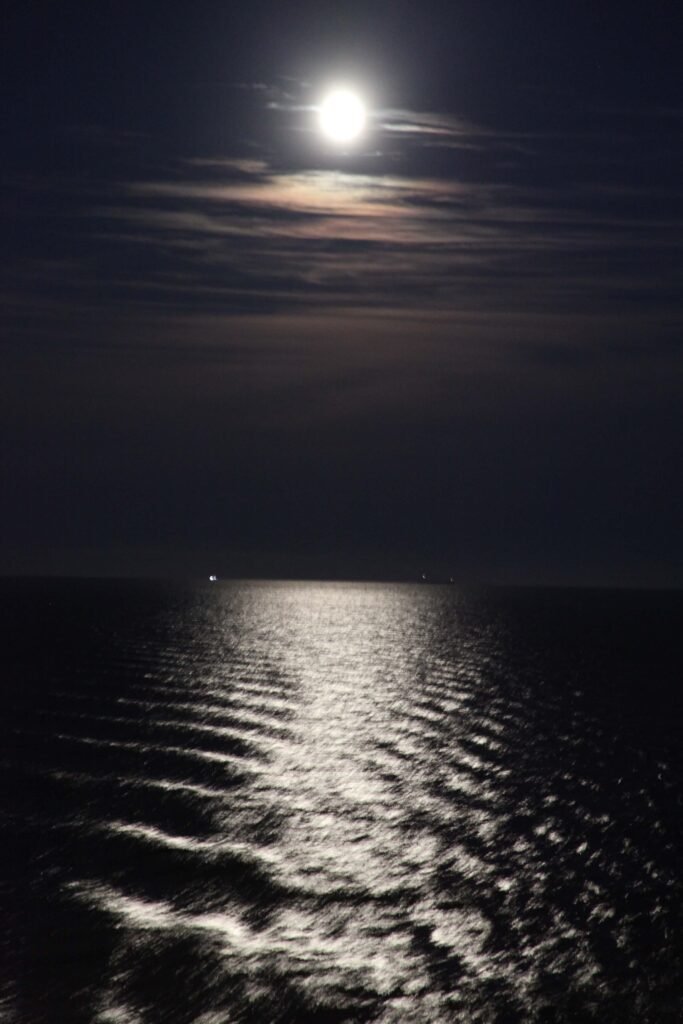
Our Fjord Line ferry left Hirtshalls in the evening.
We sampled just a touch of the cruise treatment we were missing from the generous buffet…. even my first taste of caviar!
I’m so glad I got up at six in the morning. The ferry had just docked at the only port of call, Stavanger.
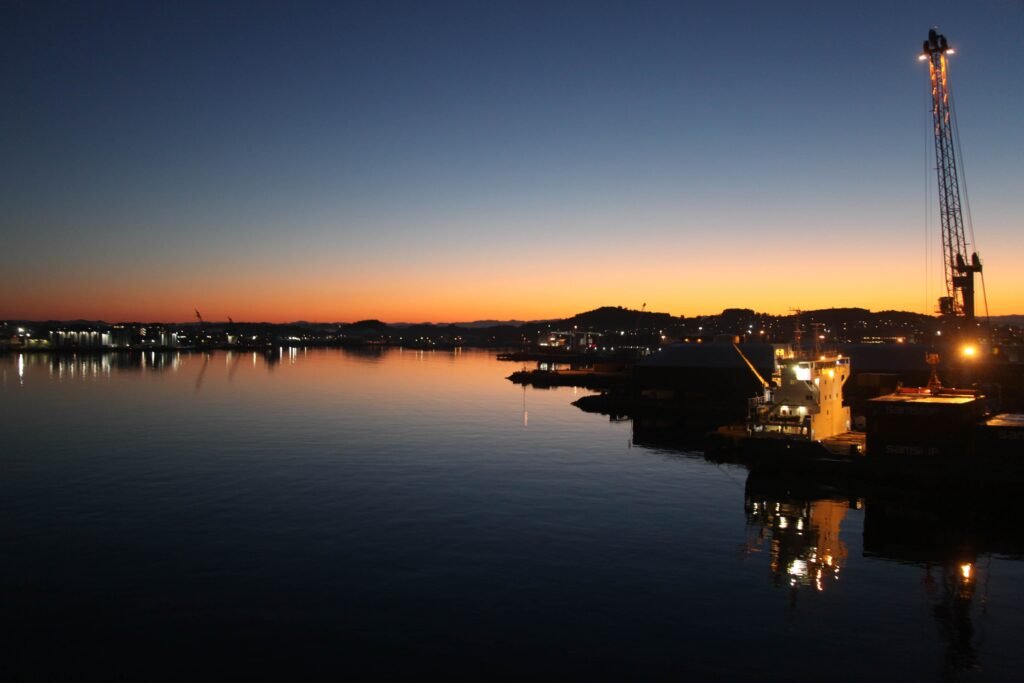
This was just the start of an amazing morning. I even saw crew taking pictures.
As the dawn began its performance to starboard, the moon was creating its own magic to port.
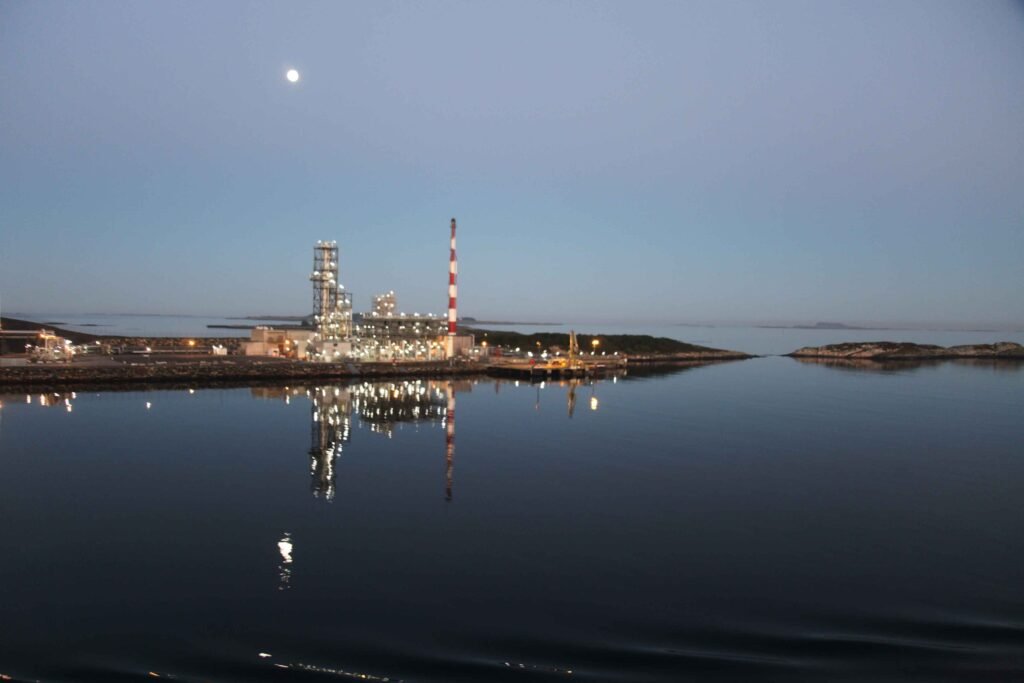
For good measure, the ferry created its own livetheflow image at the stern!

Another cloudless and virtually windless day was starting.
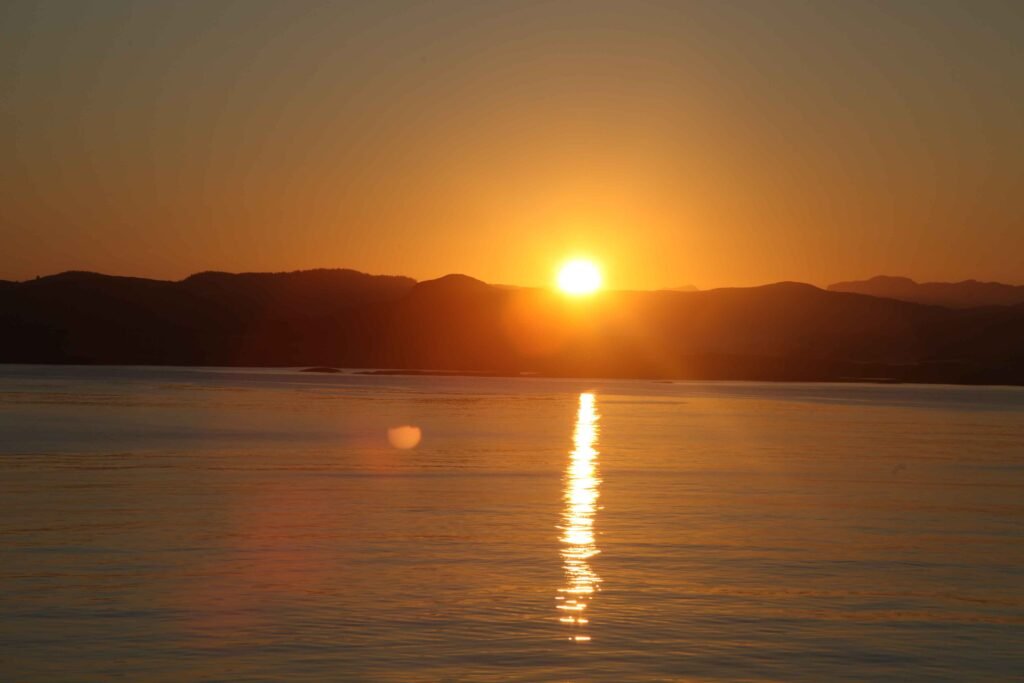
A photographer with more technical ability would have done better.
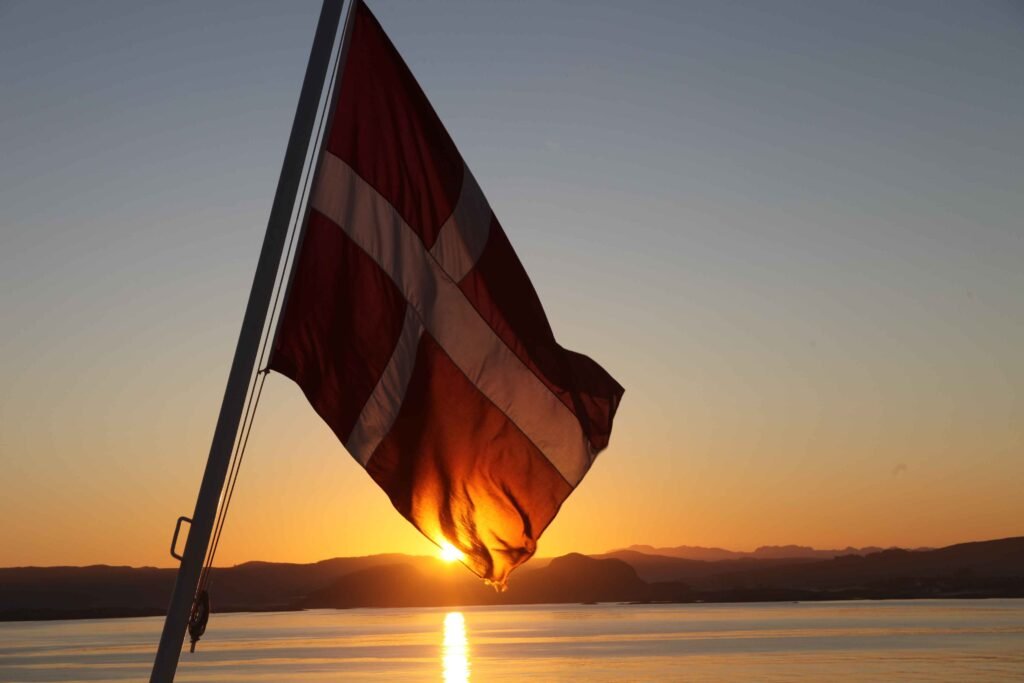
I was just blown away by what I saw. Such a privilege to see, feel and absorb the magnificence of nature. Meanwhile, probably 95% of my fellow travellers were still in their cabins …..
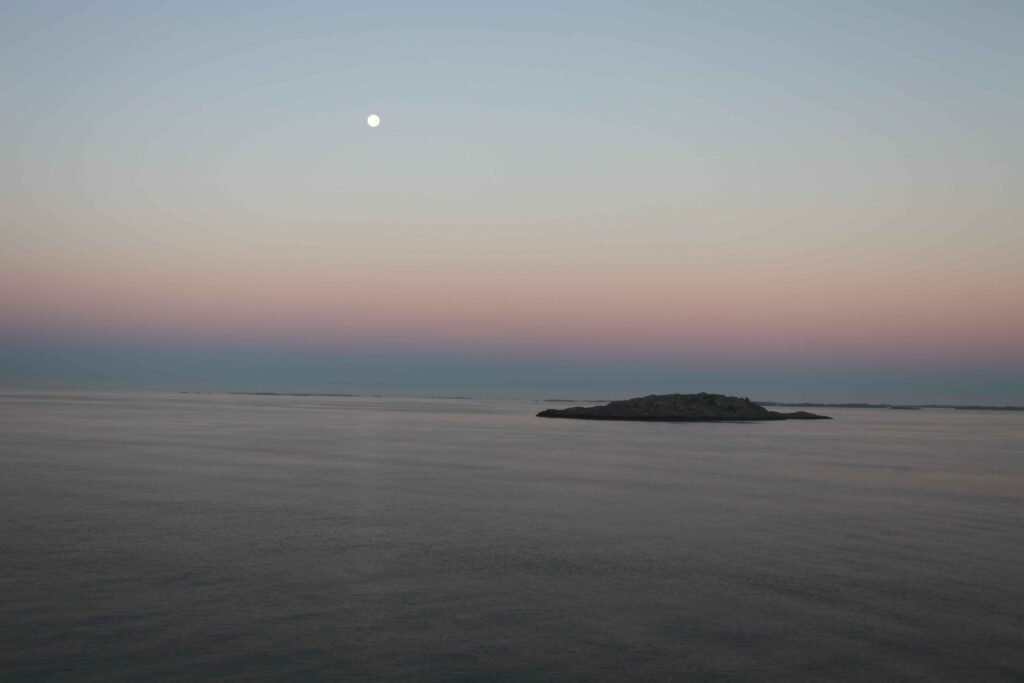
….. and the moon show continued on the other side.
The ferry did not go out to sea but threaded its way through the islands, small and large, littered around the south-west tip of mainland Norway: some inhabited, some not. Some of the larger islands are linked by spectacular bridges.
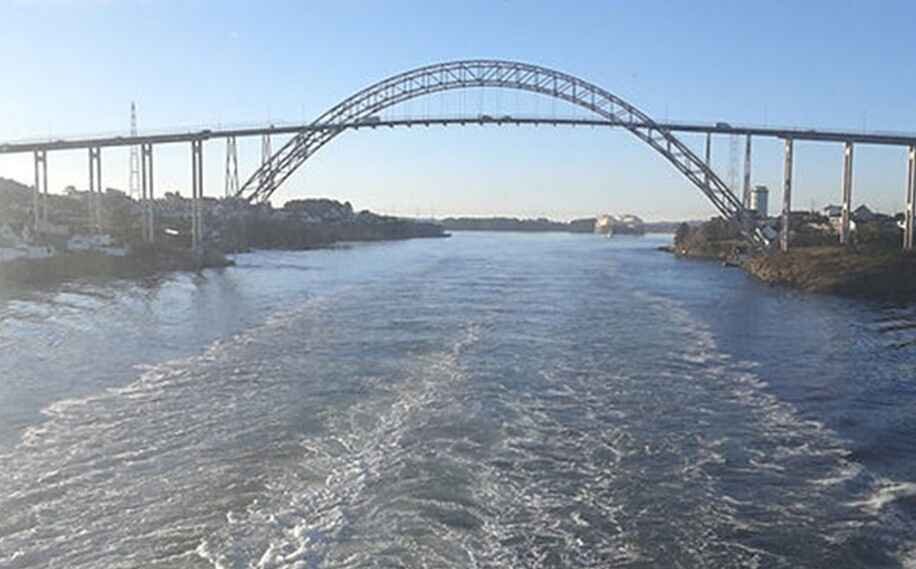
The scenery, not at this stage the narrow deep fjords, was nonetheless breathtaking. This particular morning the visual feast was enhanced by mist and fog. On one occasion, ghostly towering cranes were all that could be seen of the nearby shoreline.
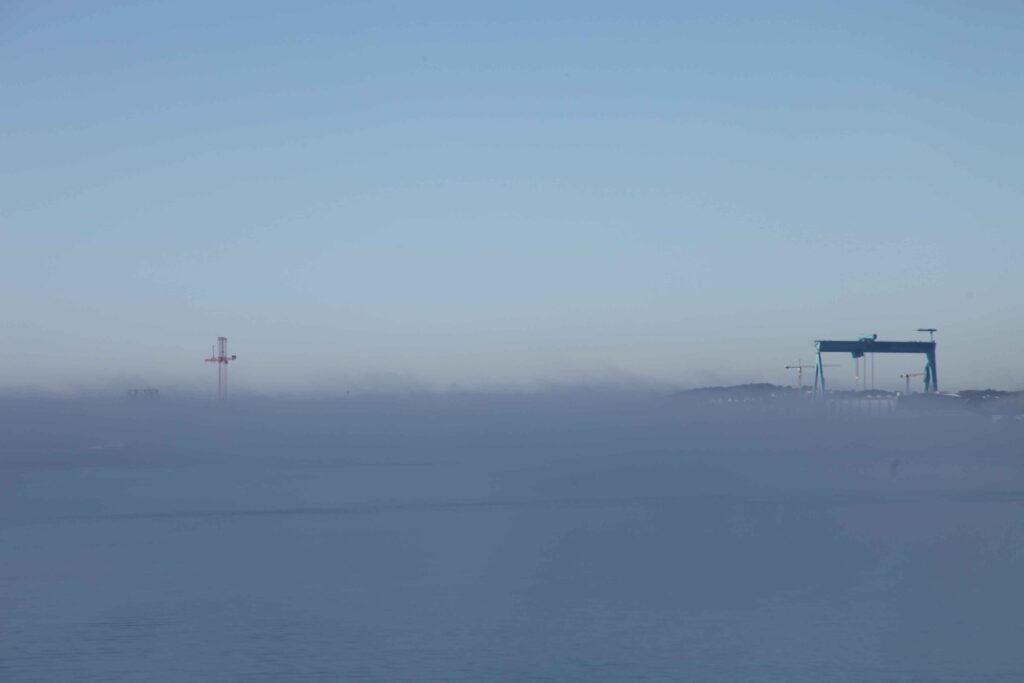
At other times, white fog banks drew lines across the near horizon with islands and other boats playing hide and seek. The sun drew bright lines across the water.
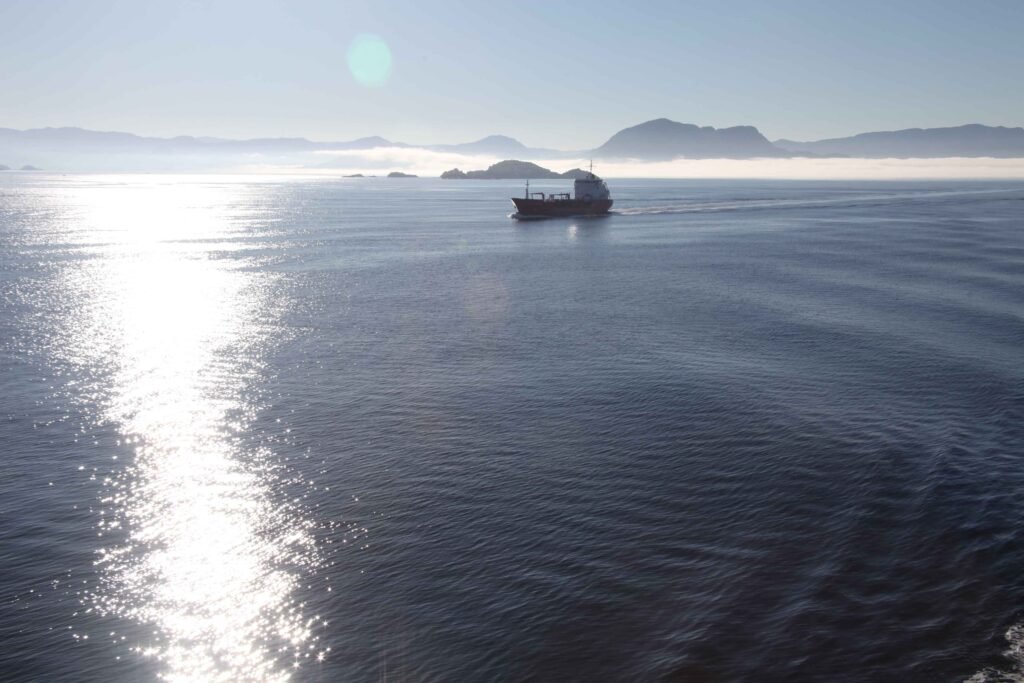
Yes, an unforgettable morning as we travelled to Bergen: a place completely unable, that day, to live up to its role as the rainiest city in Europe. Our wet weather gear was still at the bottom of the rucksack!
5. WATER, ROCK AND STUNNING VIEWS
Life in this part of Norway is dominated by the land and the water.
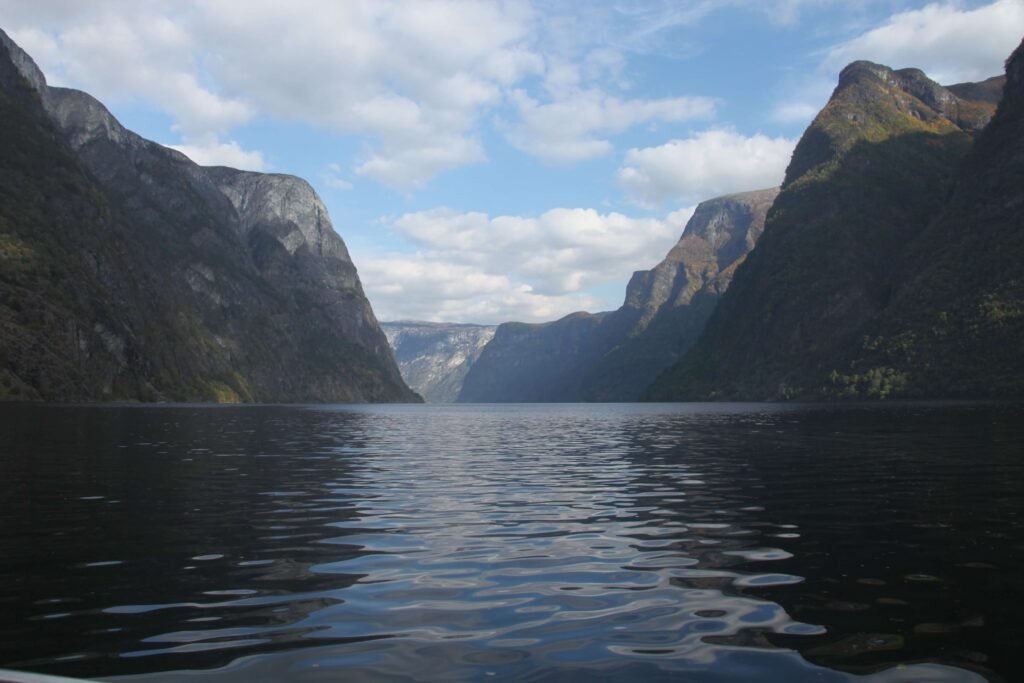
The effect is profound, especially, if you are used to a less challenging geography.
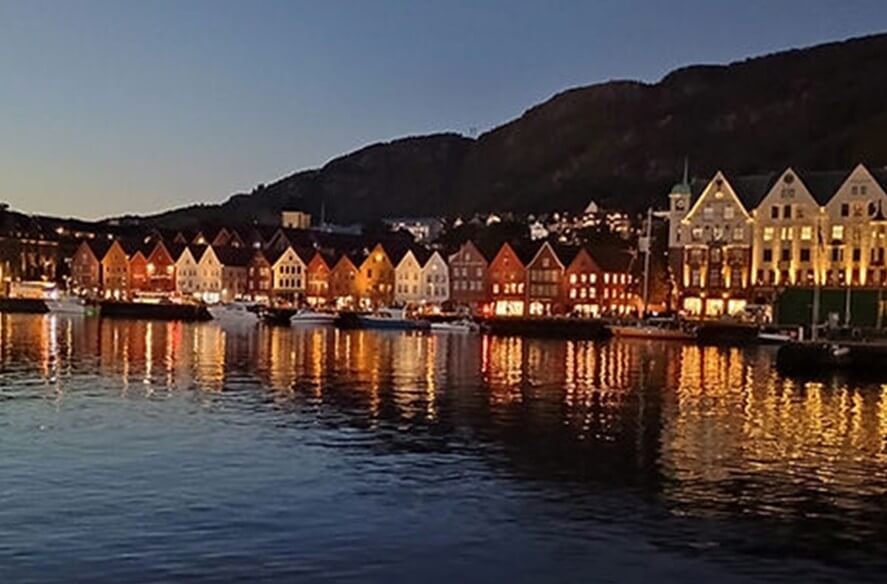
Our hostel in Bergen was well located not far from the old town waterfront. We travel relatively light and within a contained budget. So, the hostel’s facilities enabled us to catch up with the mundane realities like washing clothes. Meals out are fairly expensive, so we did more self-catering. But it was great to walk out in the evening and begin to explore.
On our first full day we did the main tourist thing and travelled up the funicular railway and enjoyed the fantastic view.
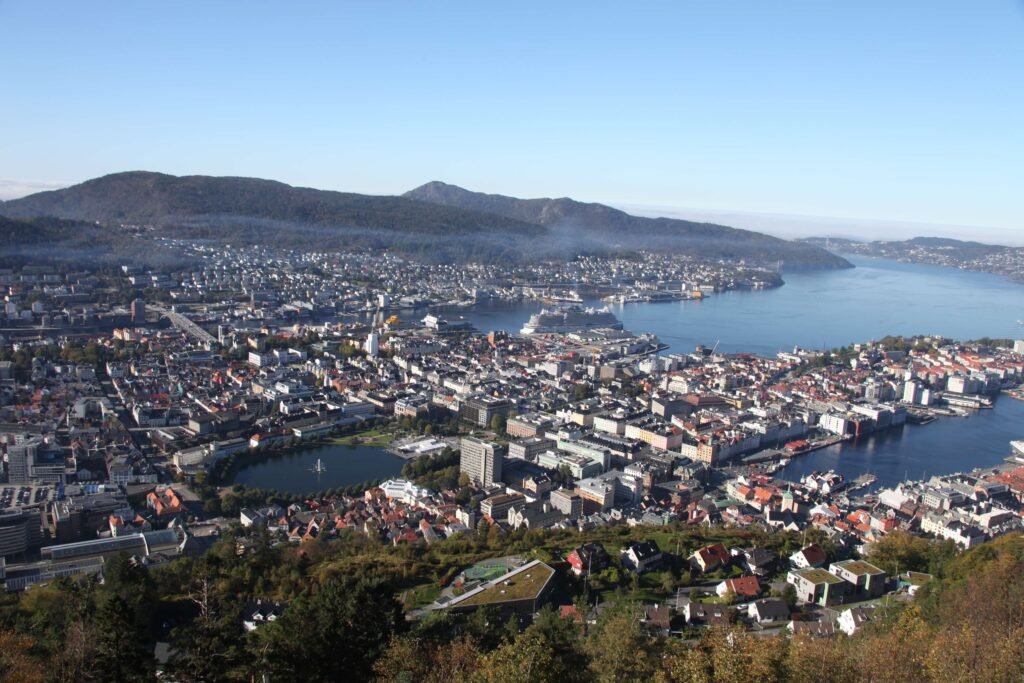
In fact, the view was so good we sent a WhatsApp picture to the family. We got an instantaneous response from Matt. I had inadvertently got a brilliant picture of the pollution trapped in the inversion layer. Look carefully at the lower part of the distant hill. [Matt models air pollution flows as part of his work.]
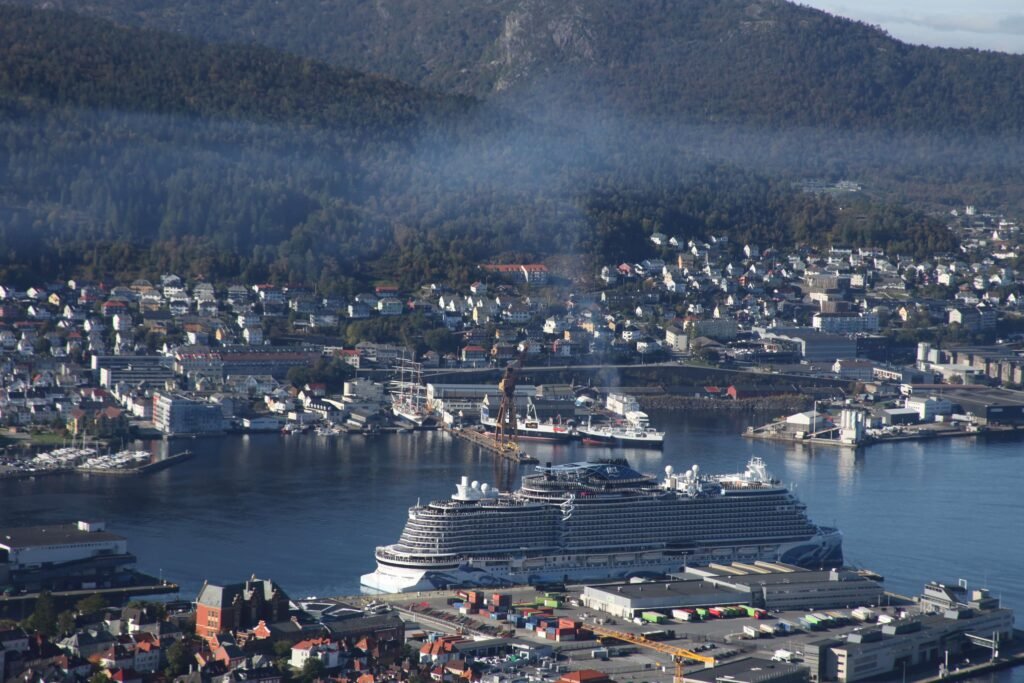
Honestly, I wasn’t going to mention them again, but it is the effect of cruise ships! The enlarged image shows exactly what is happening.
Apparently, maritime pollution is a big issue worldwide. From 2026, these ships will be progressively banned in Norway unless they can switch off their engines and connect to shore-based energy. In 2023, in each of the three main summer months, Bergen had 60 ships bringing 100,000 tourists.
That apart, we enjoyed the view with many of their passengers who soon returned. Meanwhile, we and others went on to enjoy the trails and lakes further up the hill.
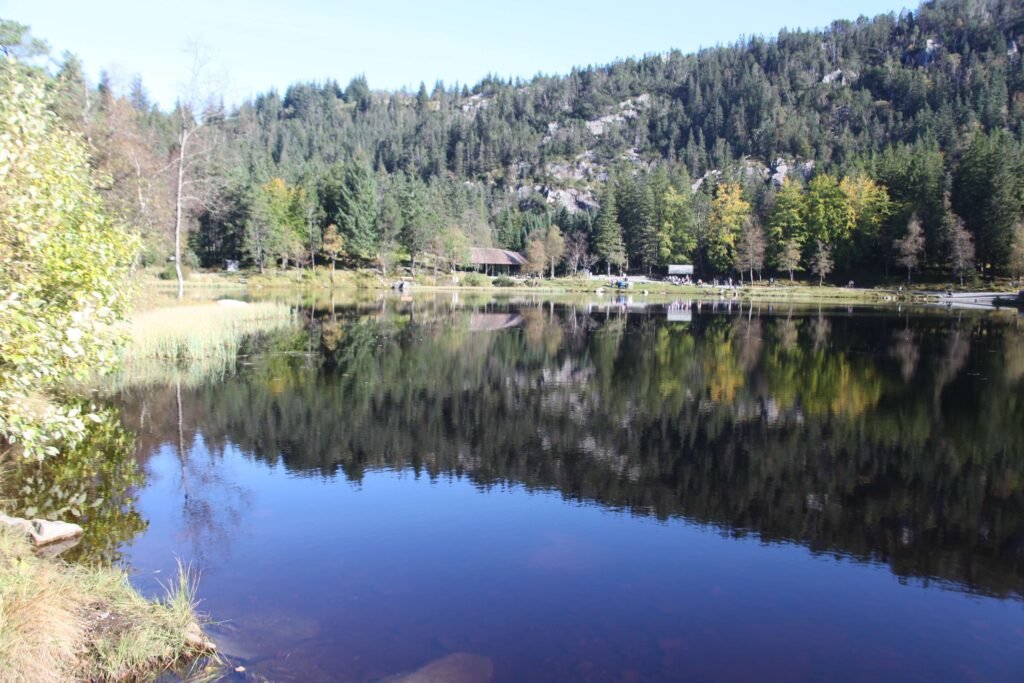
Jenni was unamused when I chose a trail that later deteriorated into a tough scramble. All I can say is that I wasn’t the only one who made this mistake … and the view …..!

On our second day, we took a boat trip. Initially, there was more mist and fog, but it cleared. Bergen is Norway’s second city. It has a population of about 270,000 with almost as many more in its immediate area. It is an important business, maritime and tourism centre.
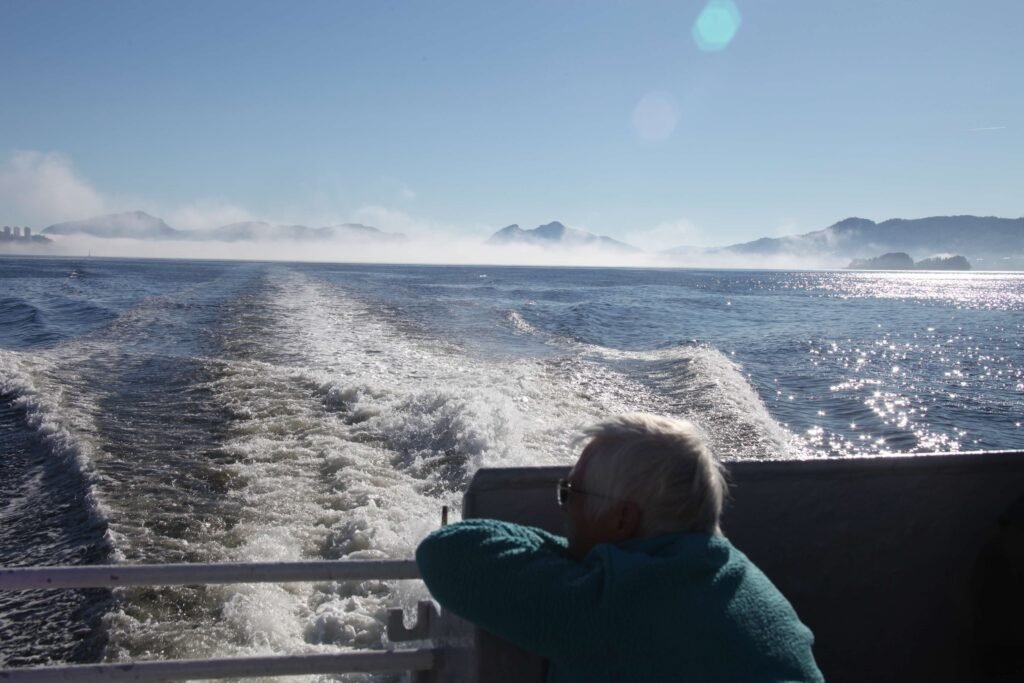
This trip up a local fjord meant we could see much more of this community on the islands and coastline. This was more like a trip on an ordinary estuary. Not until the end did it become more like the traditional steep-sided fjord.
But rock dominated. Most houses had superb sea views. But the traditional English garden was impossible and even the smallest beach was extremely rare ….. just rock. There were some interesting bridges.
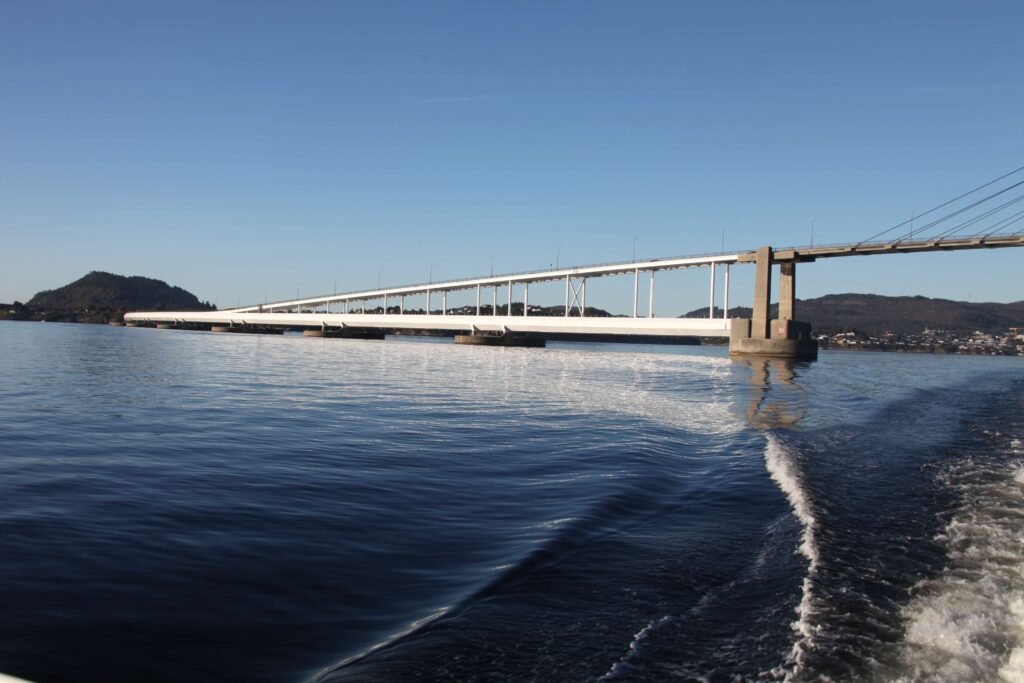
6. STOPPING OFF ON THE WAY TO OSLO
We left Bergen on the main line to Oslo but stopped at a tiny place called Myrdall to take a world-famous 20 km trip on the Flam Railway… more on these railway journeys later.
Flam is a small village at the head of one of the arms of Sognefjord, Sognefjord is one of the world’s longest fjords. Flam has a resident population of about 276. But it is the end terminal for the cruise ships that come up the fjord. It has about 175 ships every year delivering several hundred thousand visitors. Others do round trips from Bergen, combining the Flam Railway with a boat and a coach.

It was mercifully quiet when we were there. A ship with 6,000 plus was due in the next day.
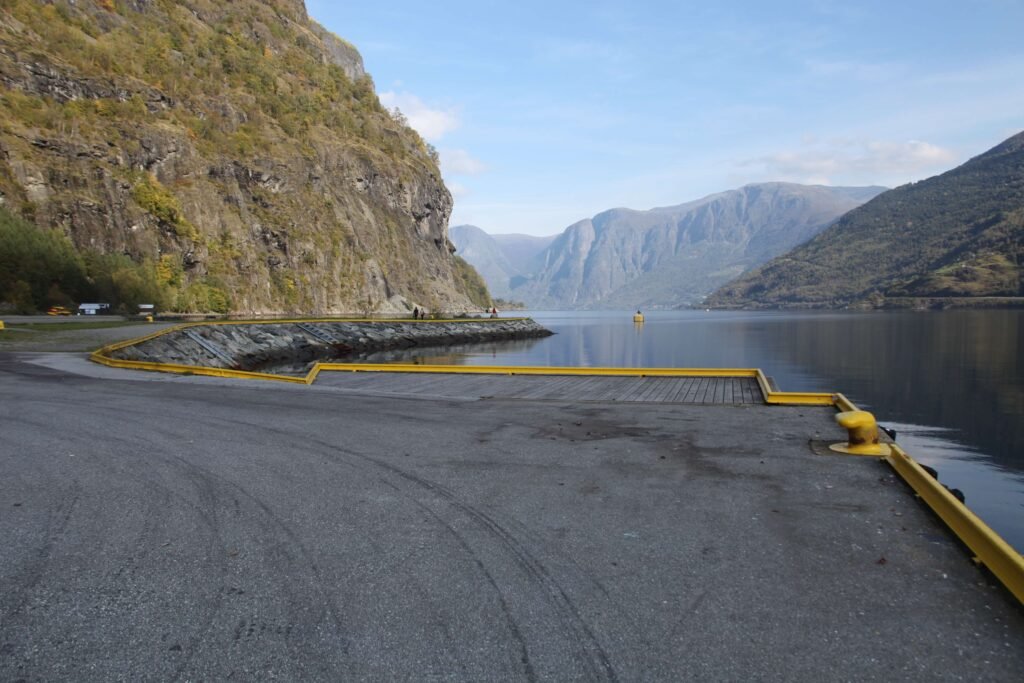
Our hostel was a converted farmhouse. It was about a mile up the valley and helped us get a feel for life here.
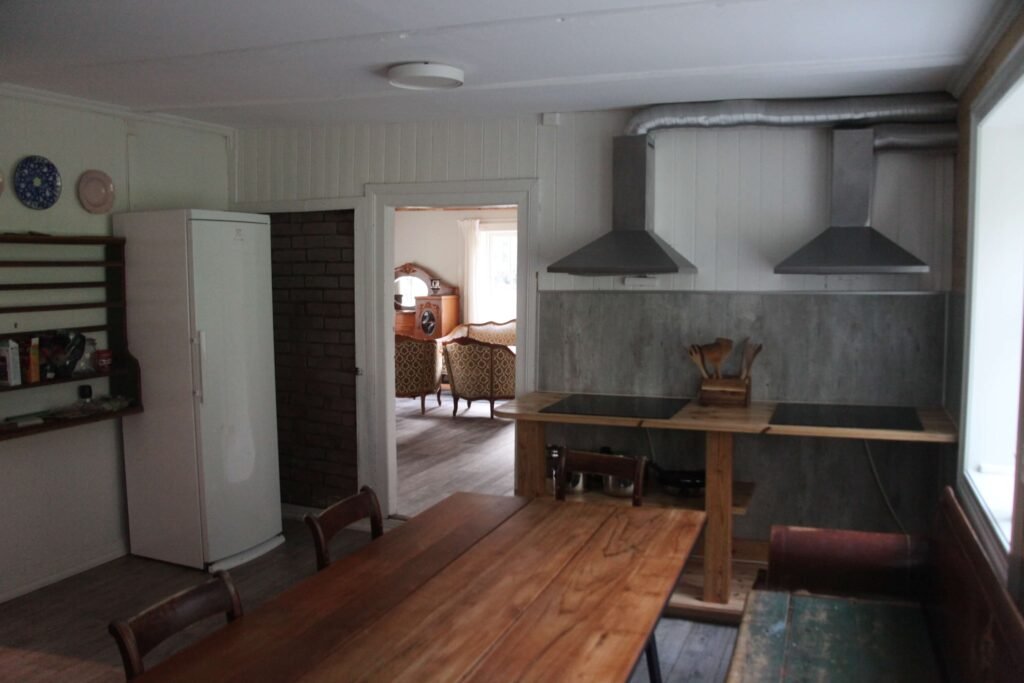
But of course there was no snow.
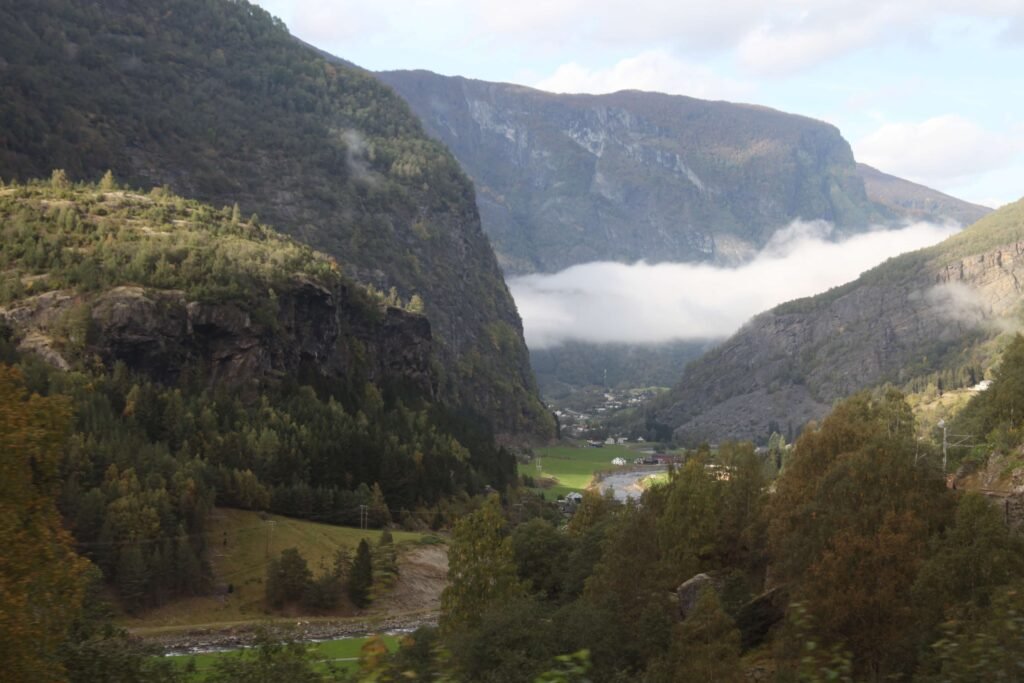
Some points, on the bottom of these deep narrow valleys can lose direct sunlight for up to four winter months!
It was great to sit outside, reading in the morning hours well after normal sunrise, yet watching the shadows recede down the valley side as the sun broke through over the top edge of the valley. Once this second sunrise reached the valley floor, I was bathed in the warmth of the sun.

You can just see the waterfall exposed by the sunlight. I had climbed a challenging 582 big rocky steps to get a glimpse of this in the mists the evening before. Legs still ache a bit.
The main event was a trip on a small fast boat. We were equipped with wet suit, automatically inflating life jacket, mittens and goggles. This passenger is virtually disappearing!
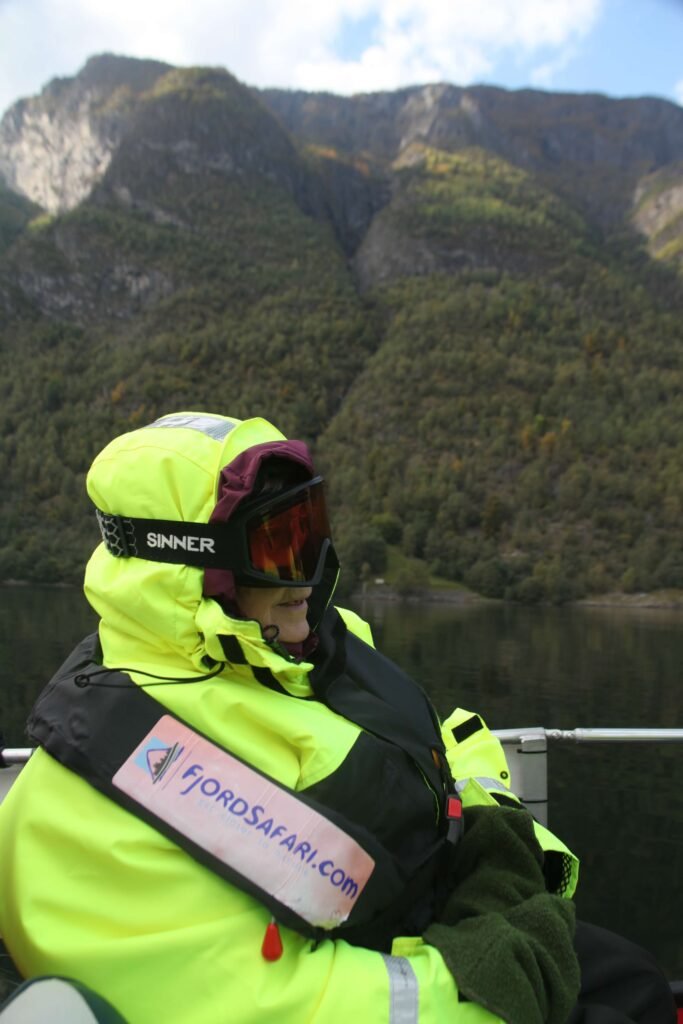
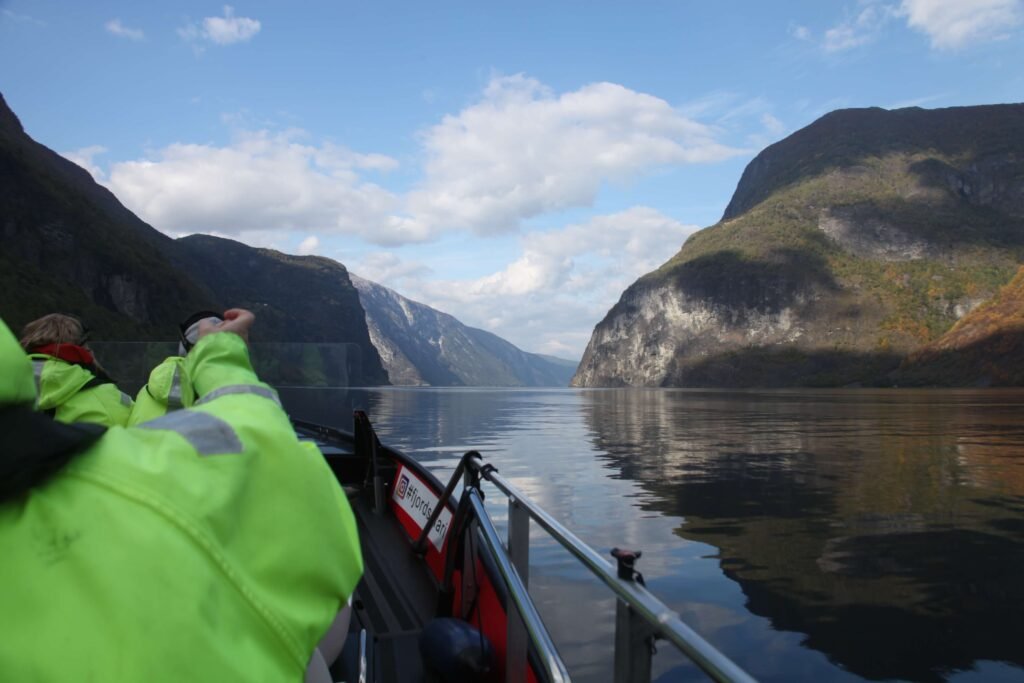
Being so close to the water enhanced the awesome experience. Majestic! We visited the narrow Naeroyfjord, a world heritage site.

Hard to convey the size of it all. Spot the tractor!

It was a beautiful and profound experience. Just imagine it in winter! A different perspective on life ….. livetheflow!
7. HIGH ON THE WORLD TICK-BOX TOURISM LIST
THE FLAM RAILWAY: ON TRACK AND DRIED OUT
We have been privileged to complete two world-renowned railway journeys. The foremost of these has to be the relatively short Flam Railway. In 20 km, it descends 864m. The stats compete with the views for admiration. It is one of the steepest standard gauge railways in the world, with 80% at a gradient of 1 to 5.5.
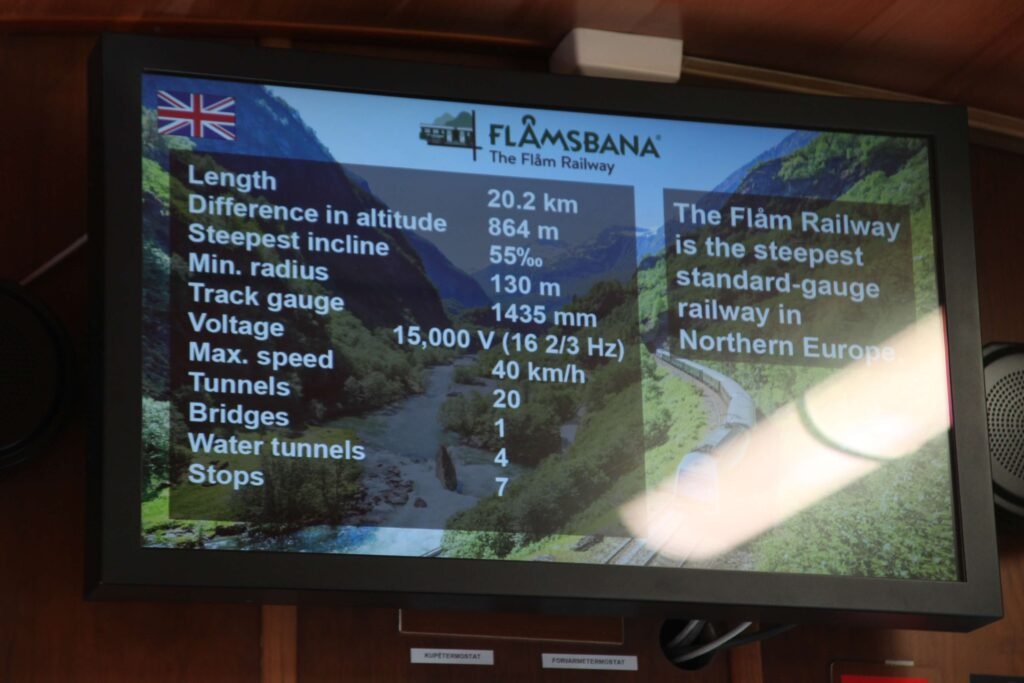
It was built between 1923 and 1940. 18 of the 20 tunnels were built by hand: one navie needed a month to carve out one metre. 17 years of work to build 20 km. Imagine HS2 built by hand …. perhaps not!
It is difficult to take pictures through closed train windows in various states of cleanliness whilst on the move. I got a beautiful view of Chester Racecourse at sunrise on our outward journey, but the window was filthy. This next picture, on the Flam Railway, is a classic and illustrates the problems:
- I have managed to obscure the central aspect of the view with a stanchion holding the overhead power line.
- The picture is off horizontal.
- The foreground is blurred.
- The reflection of the carriage light looks like a shooting star in the valley.
- Perhaps the only mistake that is positive is the ghostly image of a fellow traveller?!
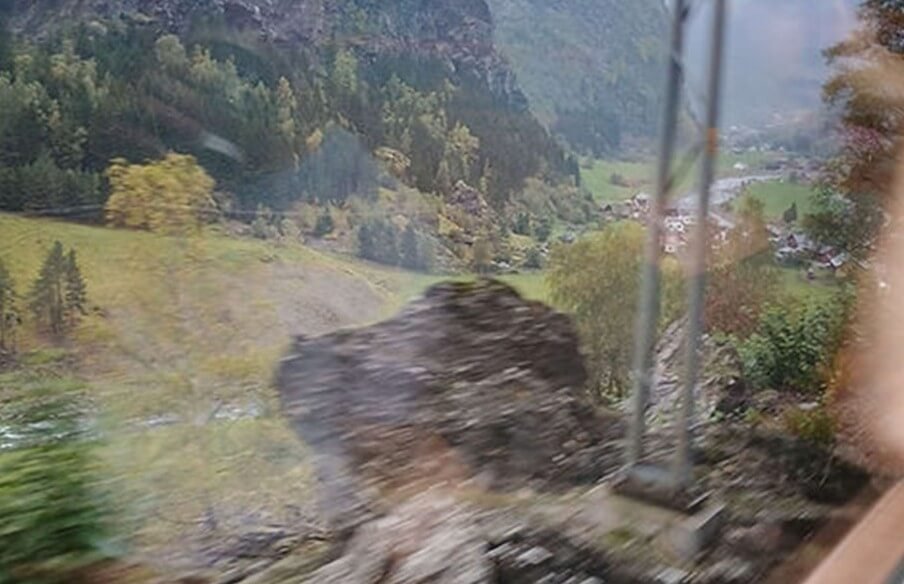
So, the quality of many of the rail journey images is poor and not worth sharing. However, the following was taken at the station before getting on. It gives a feel for the journey to come.

There are a couple of stops. One is just for passengers to get out and see the mighty Kjosfossen Waterfall. On the way down it was just a trickle. On the way back it was virtually dry thanks to the Indian Summer we have been enjoying …… whilst reading of dire floods back in the UK!
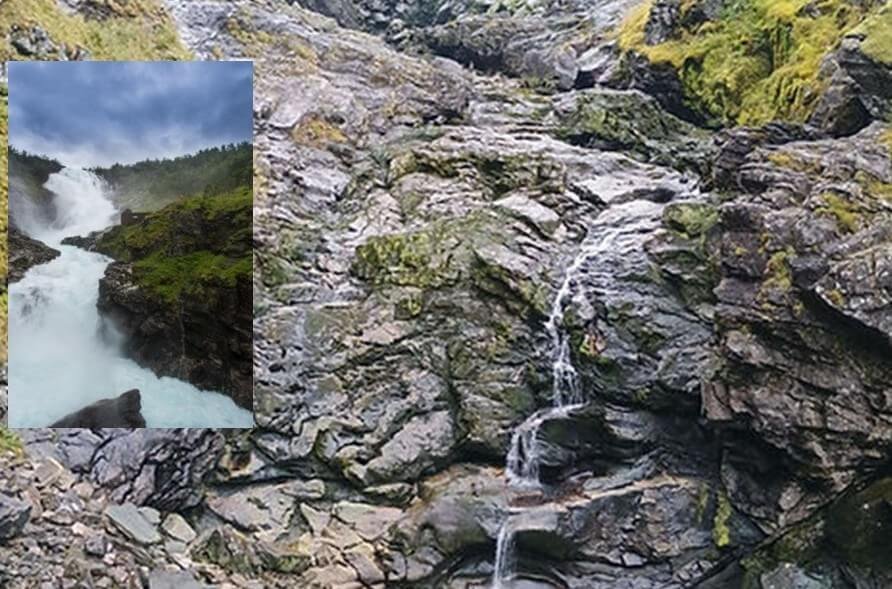
Sometimes passengers are advised to put on raincoats before getting out! Hard to imagine. Subsequently, I have put in an inset of the norm Kjosfossen Falls: the difference is staggering.]
It underlines the impact of the weather. Normally, we would have seen dozens more falls. Also, there was virtually no snow. Snow was forecast to arrive a few days after we left. We were told it brings a special beauty to the area.
Our main journey from Bergen to Oslo is also described in glowing terms. ‘Exhilarating” is one word used. The climb up from Bergen has many wonderful views of lakes. The line snakes it way along the valley / fjord side often winding through tunnels both short and long. There is no way this part of Norway can have fast trains. The track is rarely straight even for a few hundred metres.

The train climbs up to the mountain plateau, one of the largest in Europe. The area It crosses is a National Park. You get a glimpse of a couple of glaciers – see in the distance on both photos.
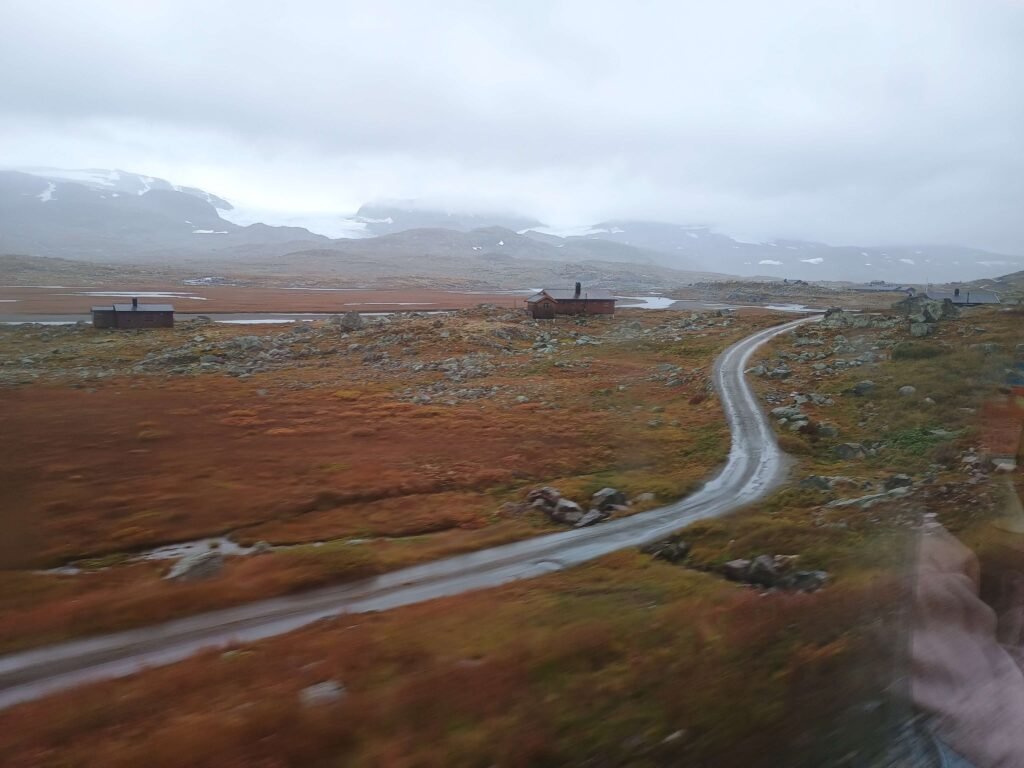
It is a truly desolate area. There are some wooden ‘tunnels’ which, I guess, are there to shelter the track from snow drifts.
From then on it is largely downhill to Oslo through large forests, many valleys and alongside many rivers and lakes. Gradually, the number and size of settlements increase. As you get nearer to Oslo the land becomes amenable to agriculture and normal industries appear.
It is a very scenic journey.
8. 48 HOURS IN OSLO
STIMULATING AND RELAXING
One of the challenges of this type of holiday is getting an immediate grip on what the cities you visit have to offer that interest you …. on top of just finding your way around with the least hassle and expense! We managed well in Oslo.
Our hostel was about a 15-minute walk from the station but there was a tram stop outside. So, we bought a city pass giving free transport on the buses, trams and ferries and access to about 30 museums and places of interest. These passes are not always worth it, but this time it was.
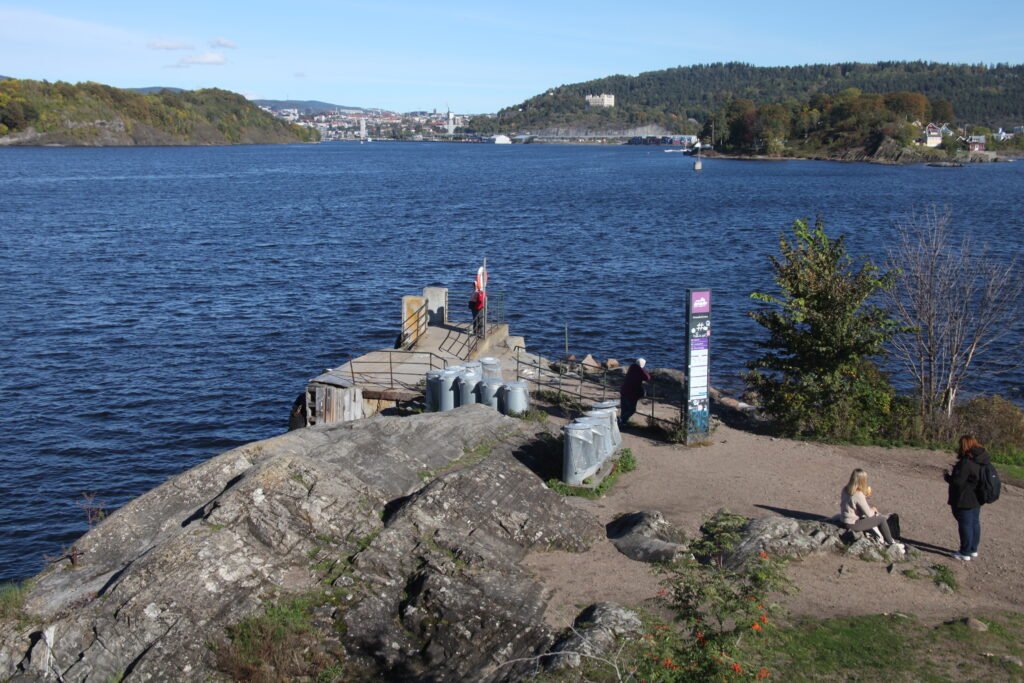
Oslo is a big port with many peninsulas and islands. It reminded us of Auckland when we visited family there. Many old dock areas have plush new apartment blocks with the best all having their balconies and sea views.
On our first day, the forecast was indifferent: virtually our first rain of the holiday! But it turned out mostly good. We discovered more about three prominent Norwegians: Vigeland, Heyerdal and Munch. First, we took a tram a little way out of the centre to a sculpture park in complete ignorance of our first Norwegian, Gustav Vigeland 1869-1943.
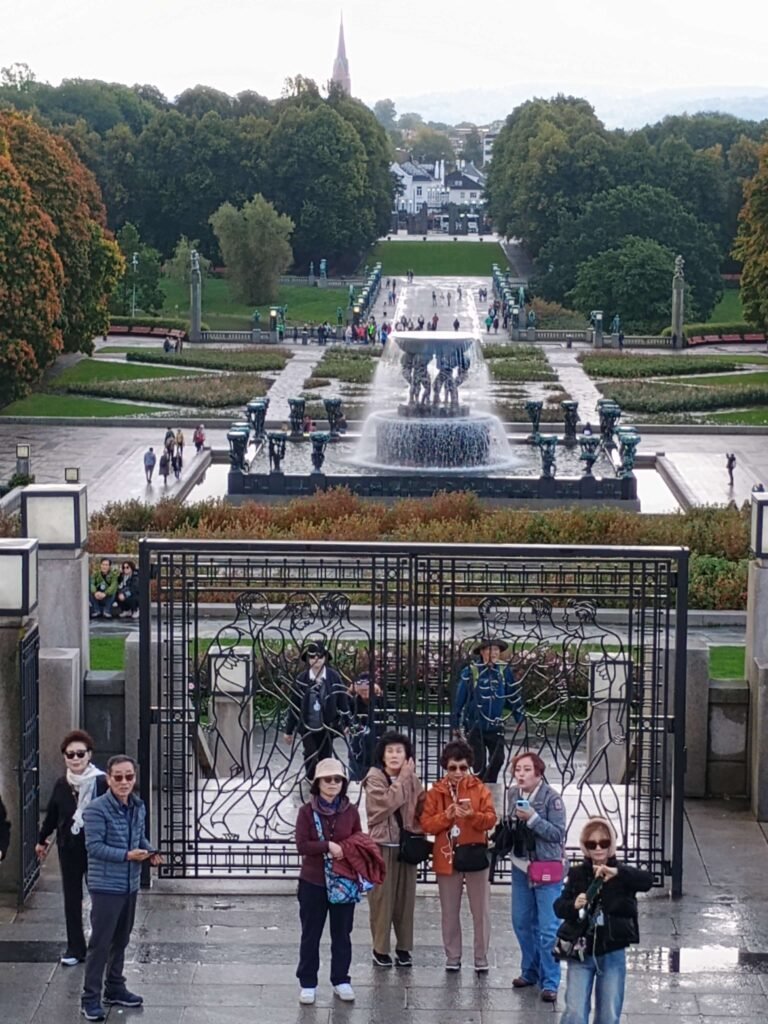
He achieved fame in his lifetime and devoted the last 20 years of his life to this sculpture park were there are over 200 bronze and granite statues. With the adjacent museum, it was a memorable visit.

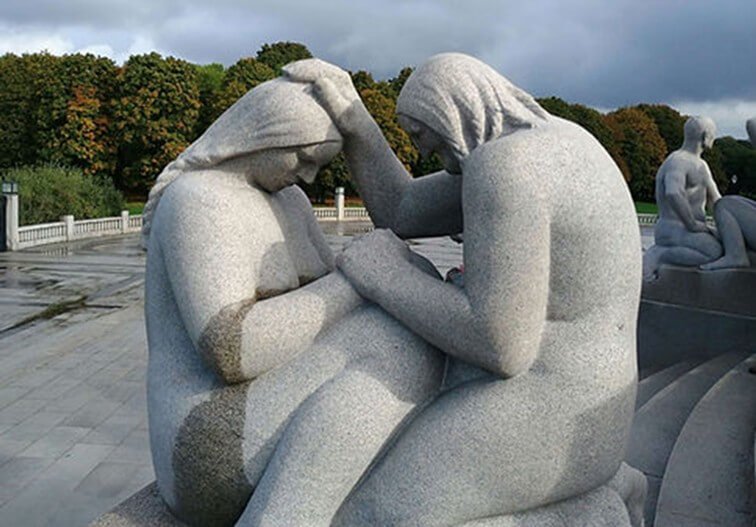
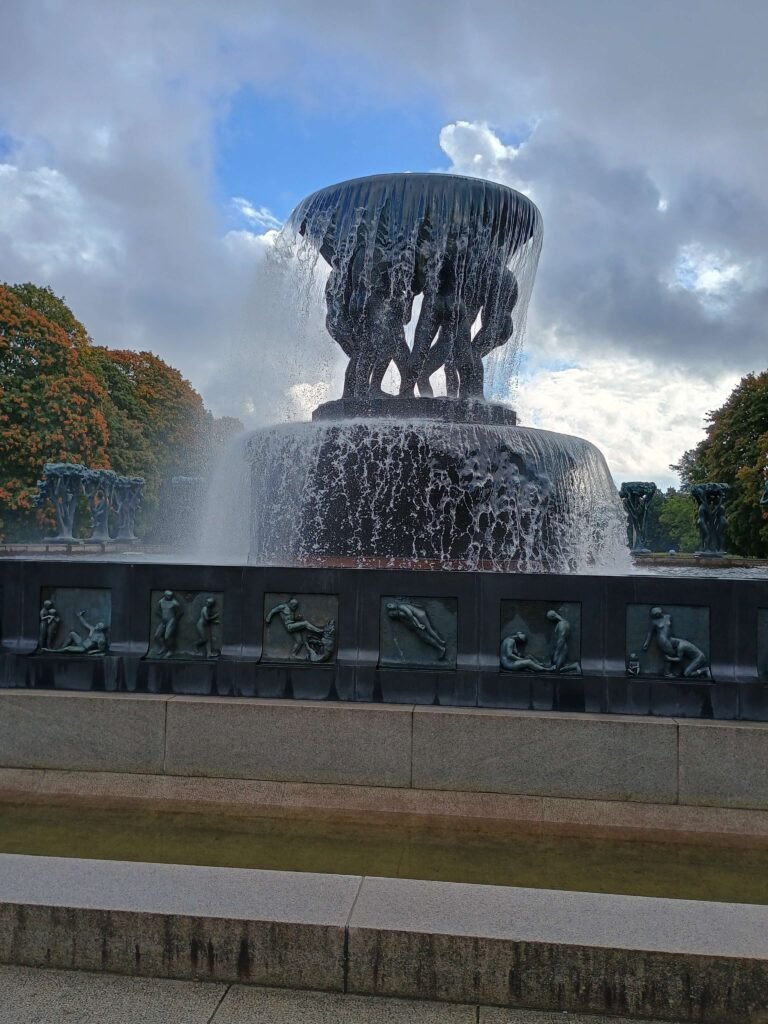
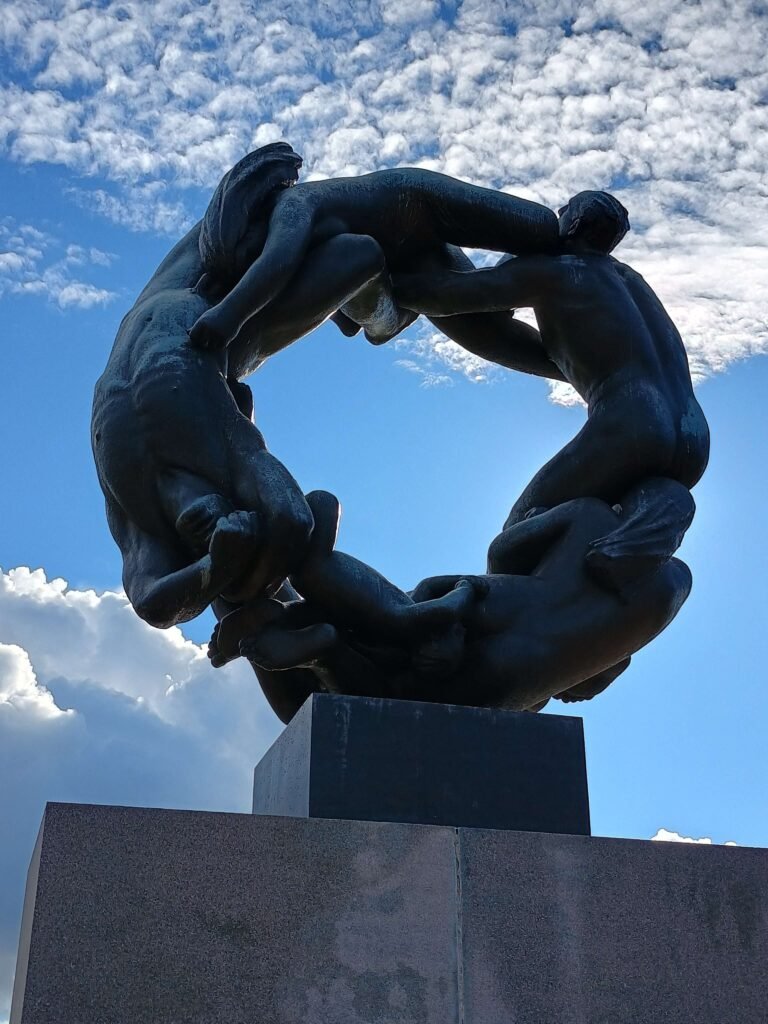
…. and in the museum exhibiting many casts and more.

I could have spent hours taking photo’s. The morning had fulfilled Solnit’s observation about walking [‘Travel Thoughts’ post] “The random, the unscreened, allows you to find what you do not know you are looking for, and you don’t know a place till it surprises you.” When we thought we would take a look at that sculpture park we saw on the map, we had no idea at all what we were going to see!
After this we took the tram back down to the docks and a ferry out to visit the Kon-Tiki museum. Both of us remembered Heyerdal’s exploits as he tried to prove that people travelled across oceans much earlier than was thought.

From there, after popping in very briefly to two other museums, we went back via ferry and tram for an early evening visit to the Munch Art Gallery in an imposing waterfront building. Obviously, there was a lot of his work, including the most famous, The Scream
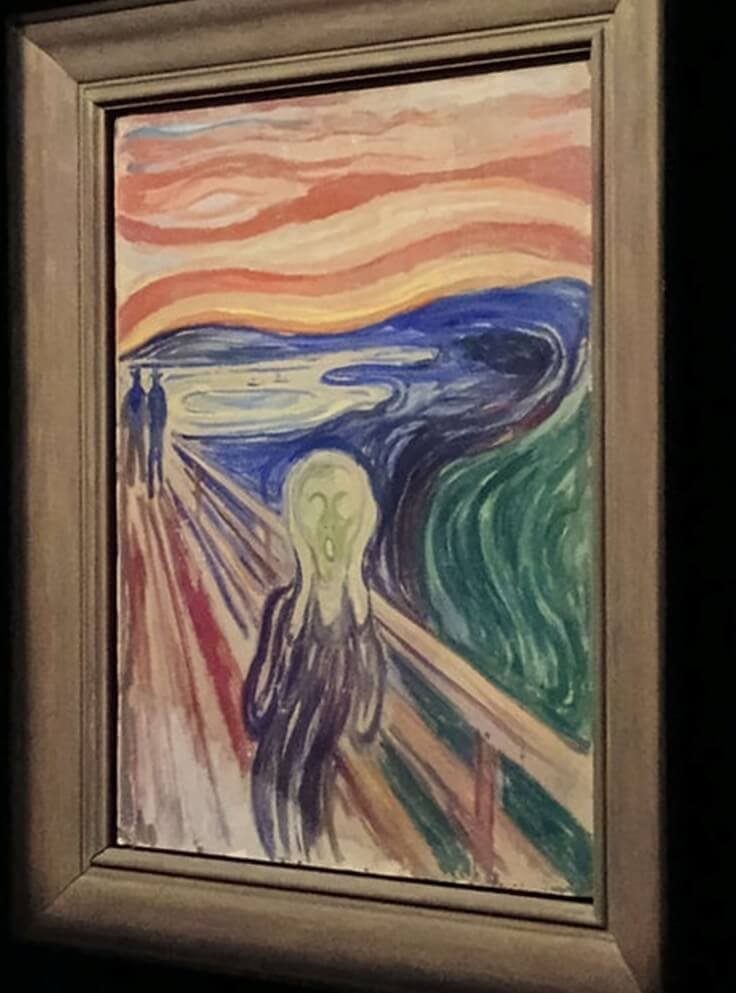
But I confess that generally Munch’s work is not for me. I was more absorbed by the nearby opera house. An interesting building with very large paved ramps allowing everyone to walk up outside on to the top of the building. The glass provided some interesting reflections.
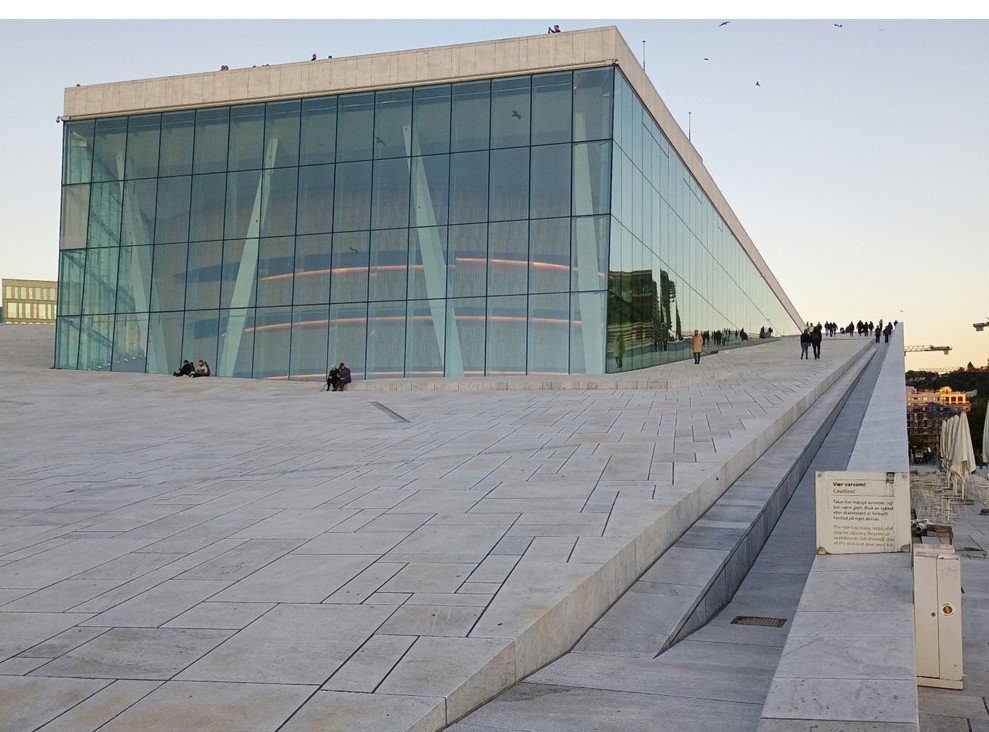
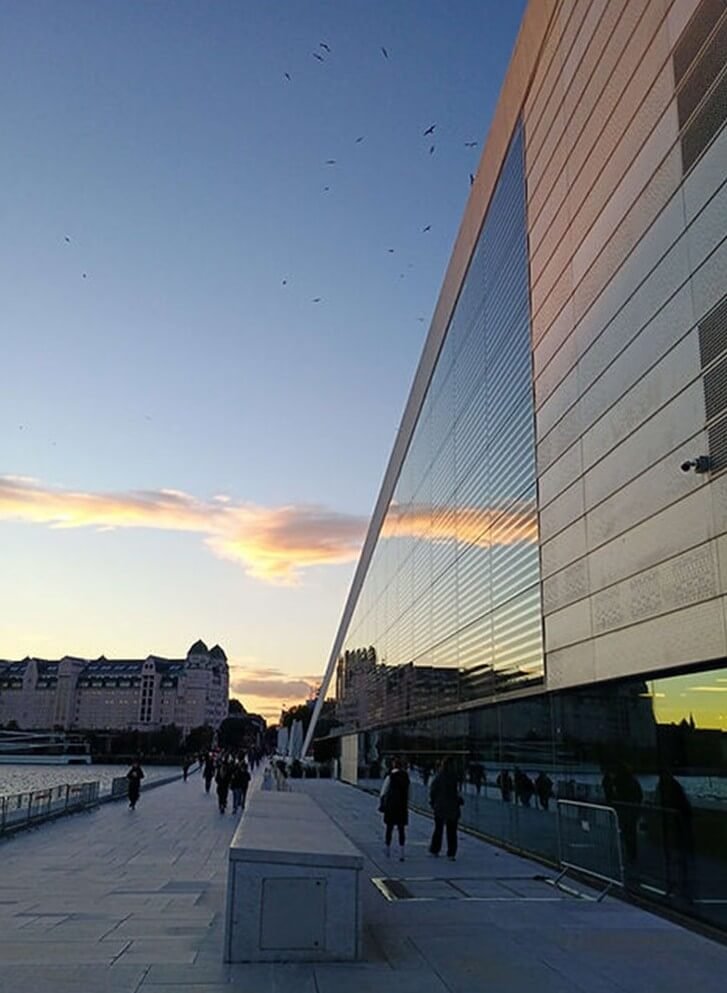
I returned at sunset to try to capture some images.
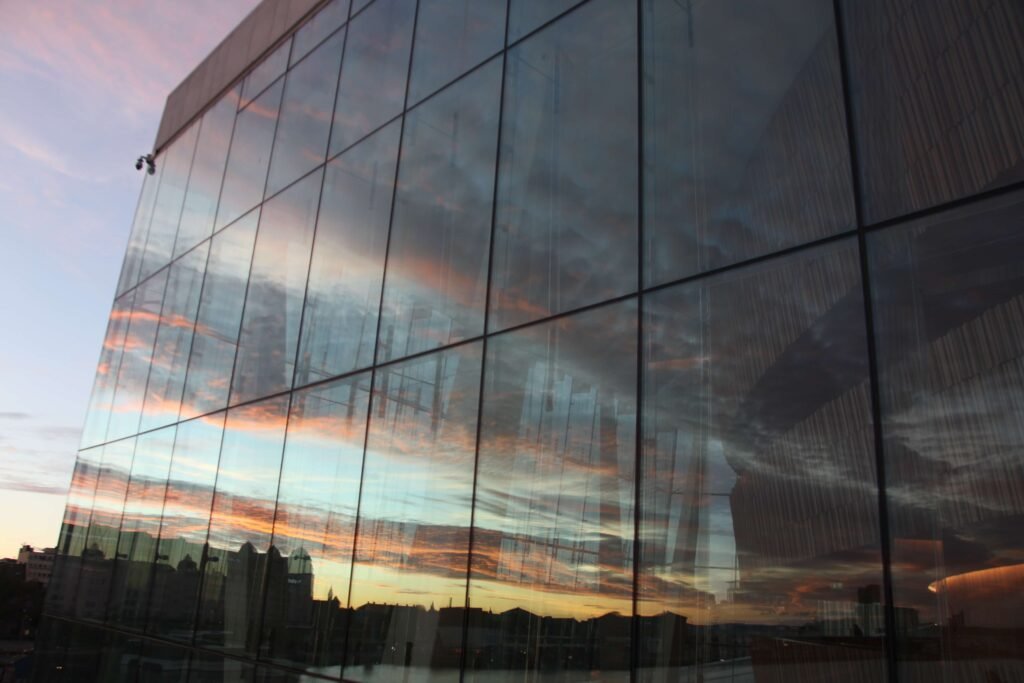
Here, young people are chatting and watching the sunset at the apex of the roof of the opera house.
How blessed we were to have fine weather,
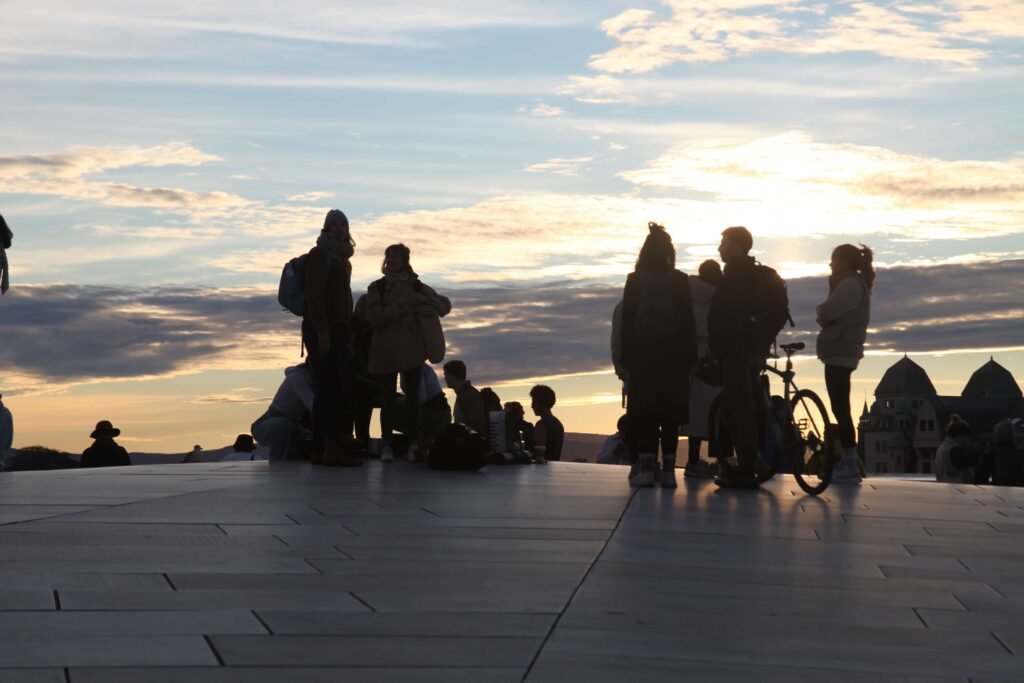
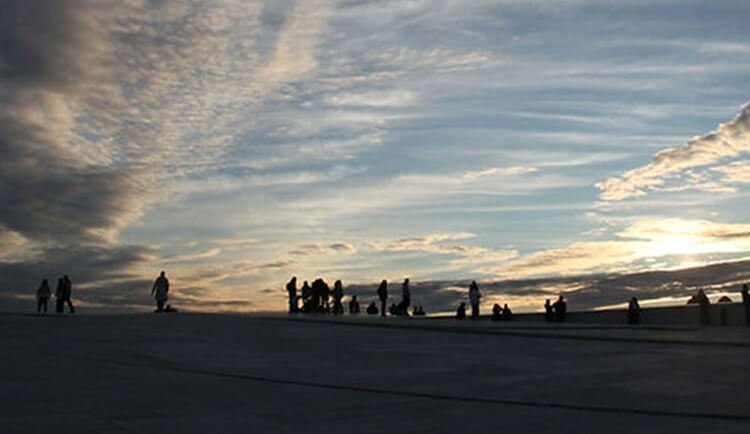
and a great sunset.
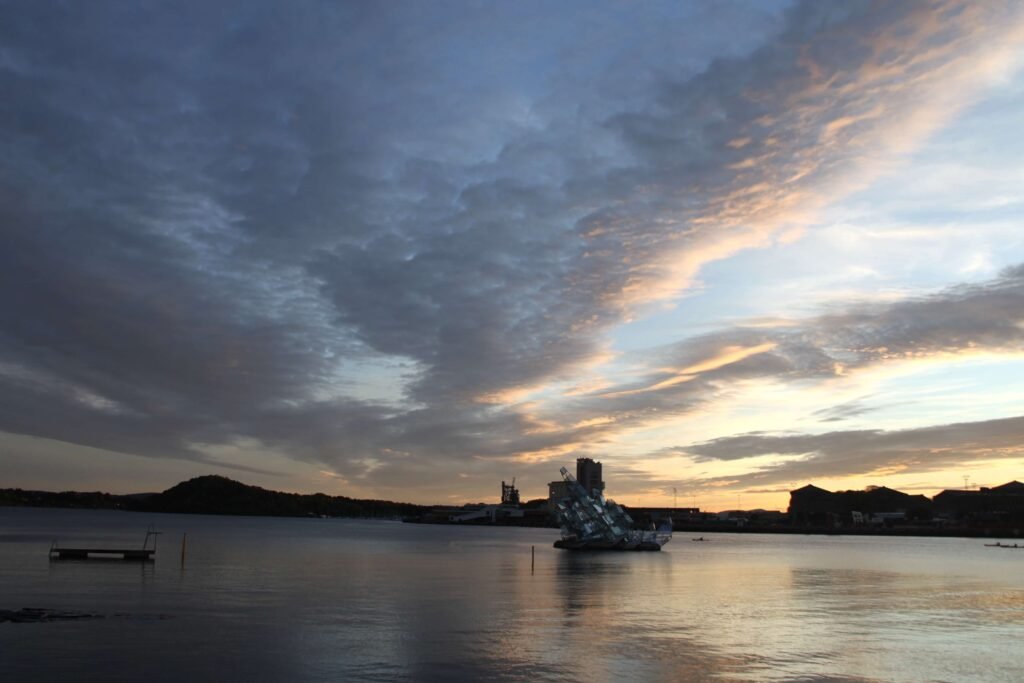
That was an energetic day. So, the next day we paid a short but interesting visit to the Resistance Museum. Norway was occupied quickly by the Nazi regime after a surprise attack. The government was in exile in London. There was extremely close cooperation with British forces. Hitler was convinced the Allies would open a second front and had 300,000 troops in Norway.
We spent the rest of the day using the ferry to visit a couple of the islands and walked around. It was a much better way to spend the time than going on a harbour boat tour.
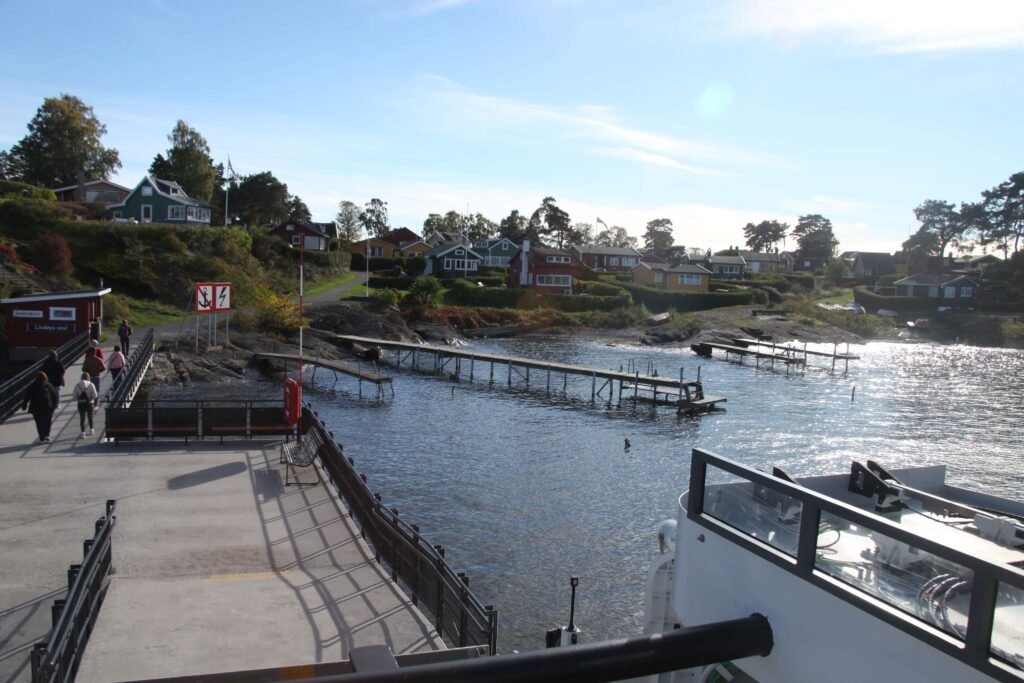
They have a fleet of relatively new electrically powered ferries. Some of the island landing stages are very small.

9. GOTHENBURG IN BRIEF
Gothenburg is the halfway point between Oslo and Copenhagen. It served in part as a respite weekend on the final leg of our journey. Gothenburg is the second city of Sweden.
With Stockholm tucked away in the Baltic, Gothenburg is Sweden’s gateway to the west. Settlements pre-existed the city which was formally founded in 1621. At that time, it was subject to ‘foreign’ influence and the first city council consisted of four Swedes, three Dutch, three Germans, and two Scots.
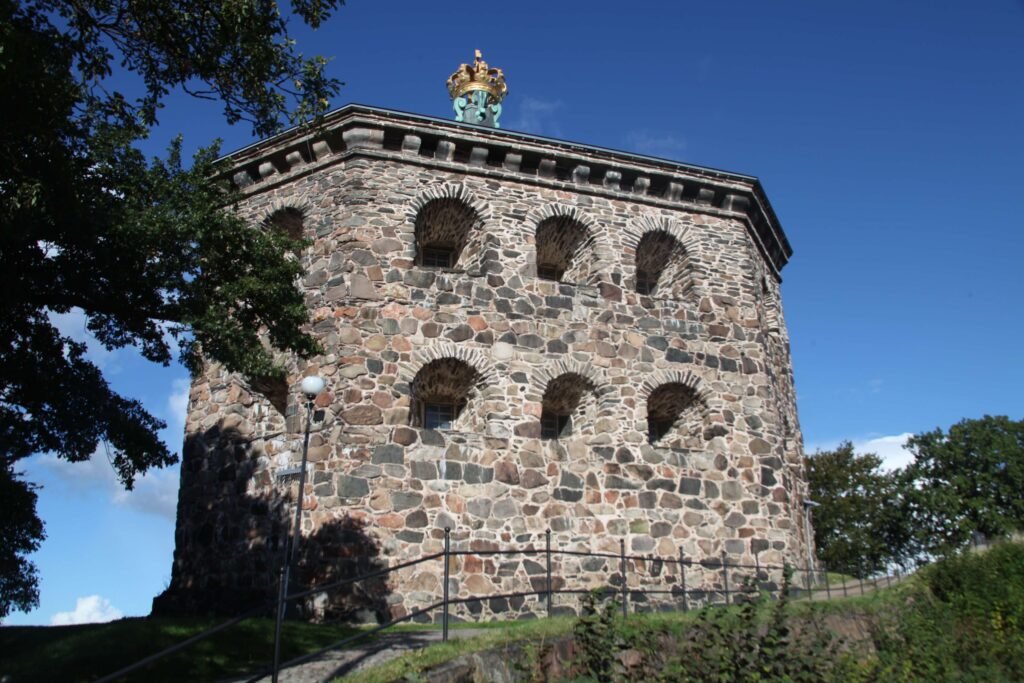
Eventually, Sweden was fully in control. This small fortress, not far from our hostel, was built on a hill overlooking the area in the late 17th century. With walls seven metres thick, it has 20 windows on each level: the bottom for cannons and the top for rifles. It has a commanding view of the city. The old port area is just visible on the left.
Gothenburg evolved from a fishing to a trading and industrial port. Like Liverpool, it was a centre for emigration. It was the base of the Swedish East India Company. Now it is the home of Volvo.
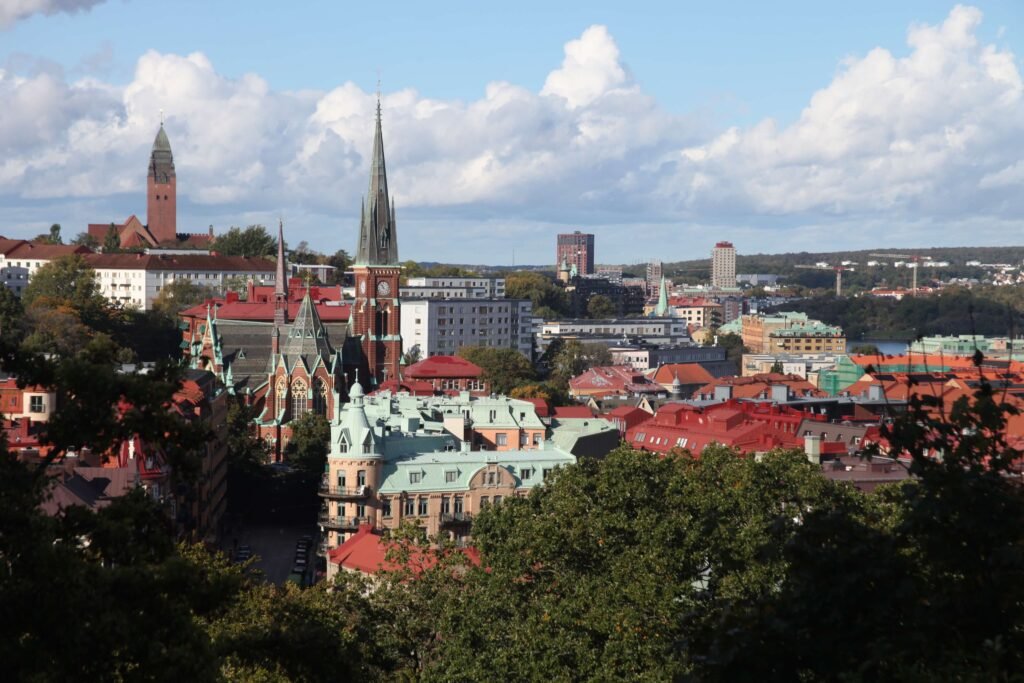
Most of the shipping now docks downstream of the Centre, but it still has an industrial feel. There’s a power station close to the centre.

We drifted around the centre of the city on our first day. We also took a sightseeing trip on the canal, which circles the old central part of the city. This is a result of the early Dutch influence: the land was quite marshy, and the canal also helped create a fortified area.
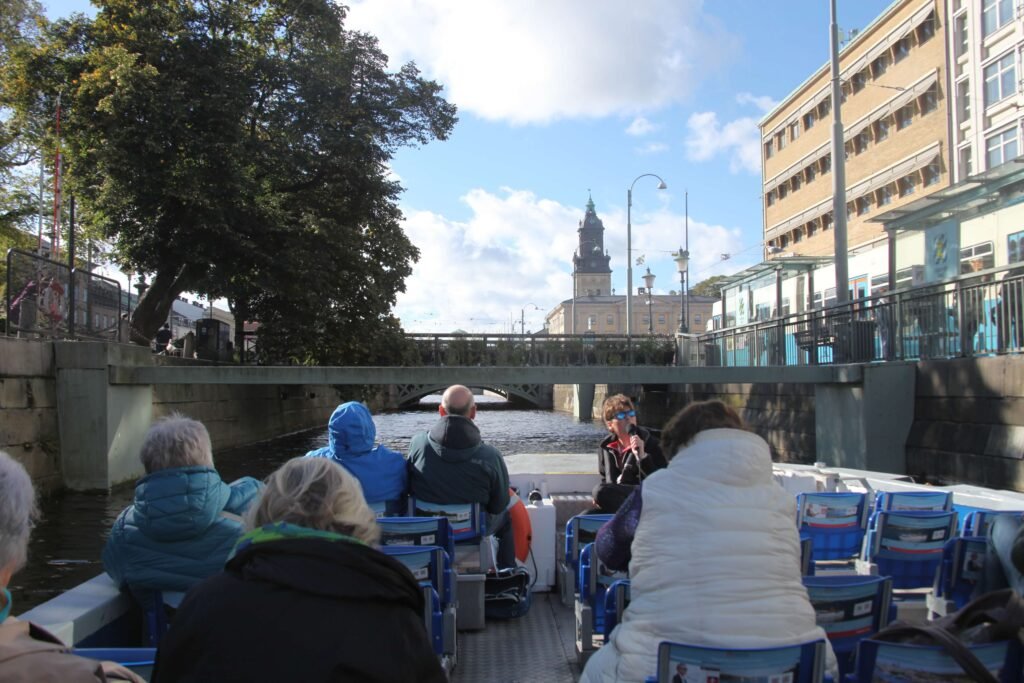
The bridges are low. One had less than 2ft clearance above the seat top. You had to duck!
The next day we explored a large 140-hectare park which was just up the road from the hostel. Part of it is hilly ground with views over the city, and part is flat. There are some small lakes and a small farm-type zoo which is free, but unfortunately, it was temporarily closed. An impressive city park.
Adjacent to the park is the Botanical Garden. The glasshouses were closed, but the rest, including an arboretum, was more like one of the RHS or National Trust gardens in the UK. I loved it. Parts are reminiscent of our much-loved Bodnant Gardens in North Wales. They make good use of the hilly and rocky terrain. Don’t miss this if you ever visit Gothenburg.
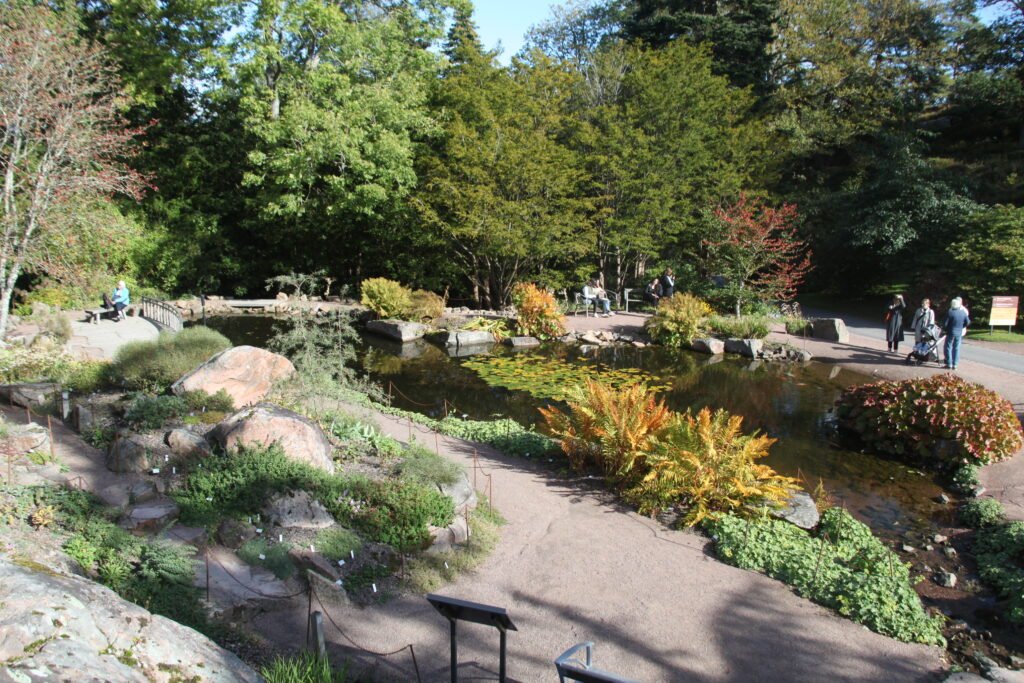
Finally, on the other side of the river, there is a really striking brand new building still being finished off inside.
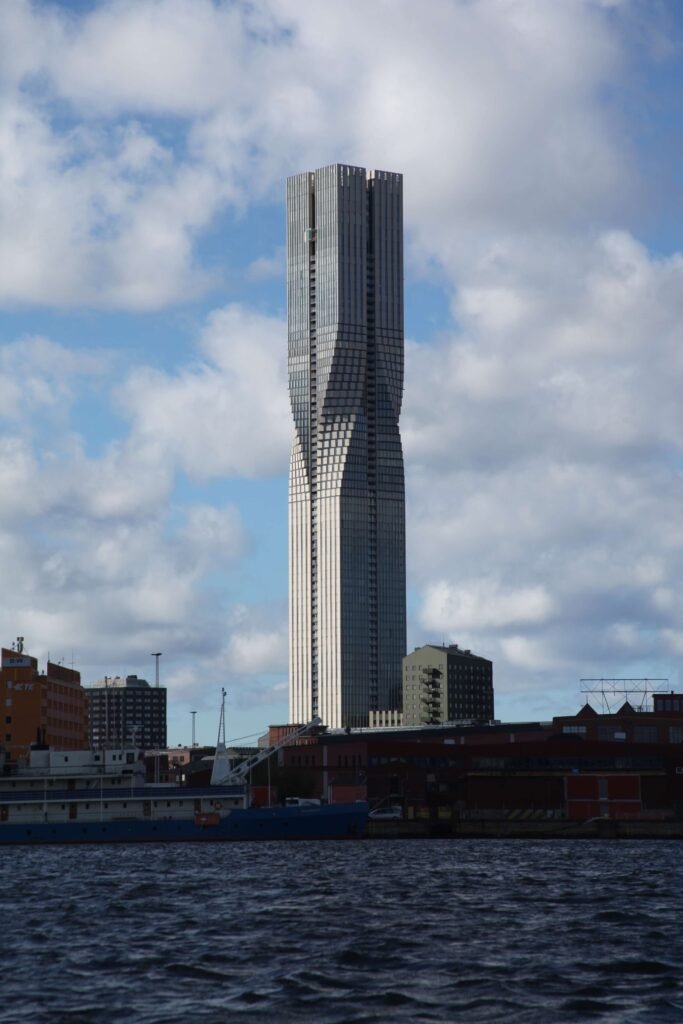
It is the Karla Tower which is to be the centre piece of a new district. It is the tallest building in Scandinavia. Its 74 floors will house over 600 apartments, offices, a hotel and a sky bar. It is designed by SOM the company who also designed Burj Khalifa, the world’s tallest building, in Dubai.
Tomorrow, Copenhagen and then home at the end of the week. Jenni is running out of tea bags!
10. COPENHAGEN: HIGHLIGHTS AND MORE
We returned to Denmark.
As we left Norway, the landscape gradually changed from the dramatic, rugged fjords to more undulating countryside with farms. Norway merged with Sweden. The land became flat with vast arable fields and enormous farms the further south we went.
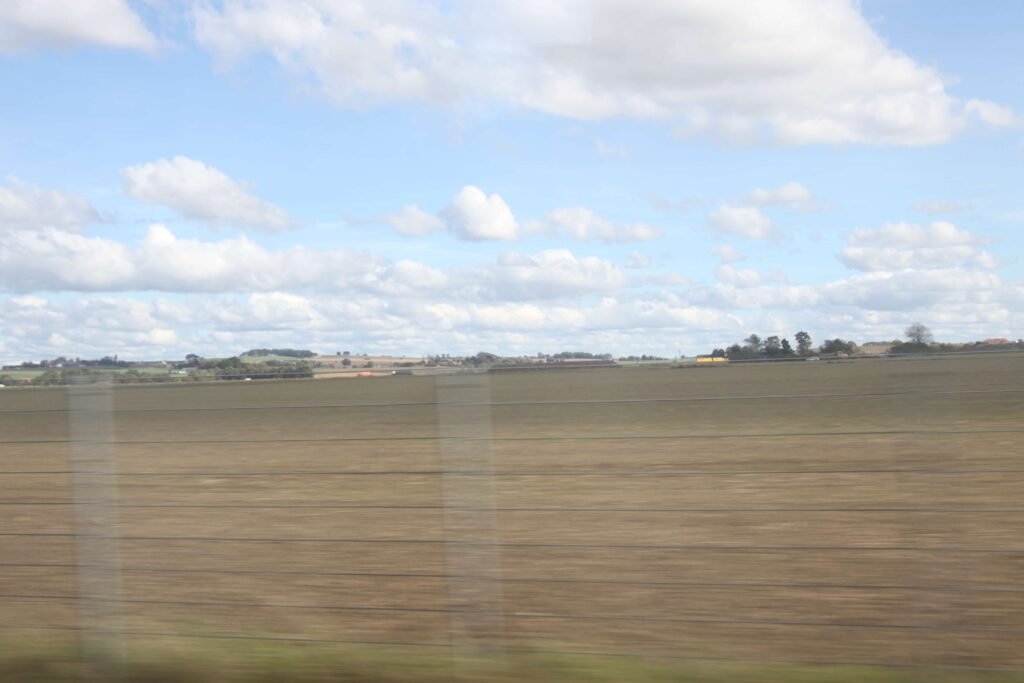
As all Scandi crime drama fans will know, we had to cross ‘The Bridge’ to go from Malmo to Copenhagen for our final three nights. Incidentally, the common Scandi visual of solitary cars travelling on straight roads is an everyday reality.
There is an abundance of things I could share from Copenhagen. Once again, we used the ‘City Card’ option, giving us unlimited city transport and access to dozens of attractions. The canal sightseeing trip helped in the process of finding our way around and identifying the things we wished to see.
All our stops have been at ports. Copenhagen is the capital of Denmark and comes with the normal set of political and royal buildings. We went to one to find that it had closed at 3 pm, but before we had worked out where to go next, the King turned up! Apparently, it was a busy day of official engagements … we weren’t asked in.
However we did “do” a Palace and the Royal Reception rooms that are used for special events. They were spectacular.
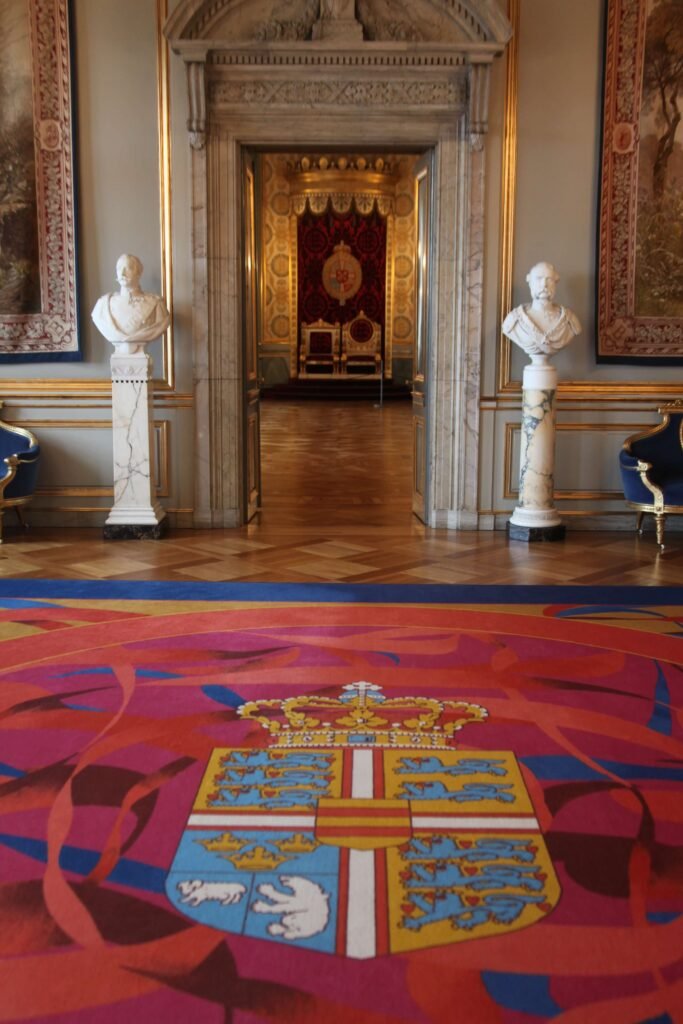
The Danish monarchy of course has connections with our own. Similarities between our culture and history and those of Denmark were evident. There were a lot of both old and modern buildings to interest and impress. All sorts of shapes and designs. Some mimicking the classic scandinavian house shape.
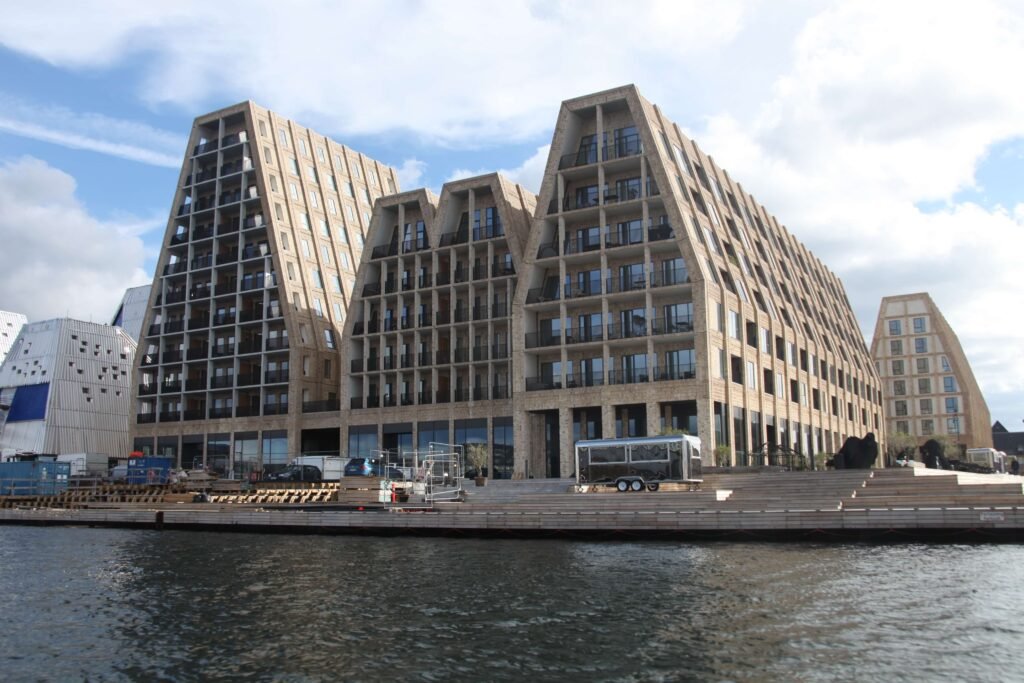
We made it to a church with an unusual spire. I made the 200 or so steps to the viewing platform at the bottom of the spire but my head for heights got lost several decades ago, so I did not attempt the final climb!
It looks at lot easier from the safety of the ground. Anyway another fantastic view… this time out towards the sea with the obligatory cruise ship on the horizon!
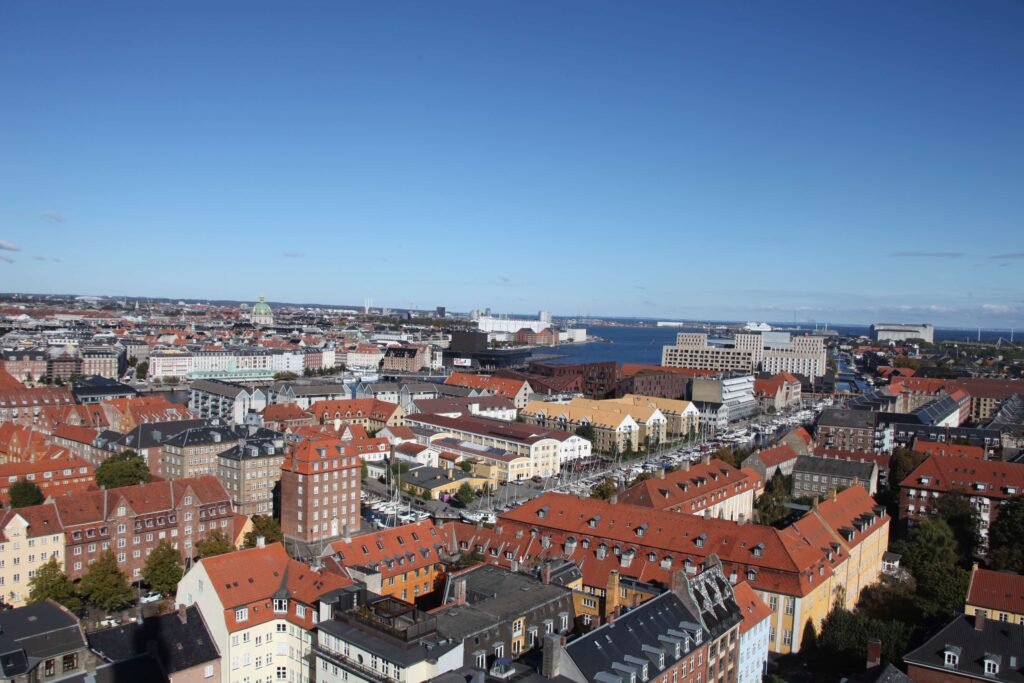
Our ‘to see’ list was impressive and included a couple of photographic exhibitions in a building called the Black Diamond… because it’s black and the front glitters because of reflections from water. The design museum had an interesting feature about designing for the future: posing all sorts of questions. (It occurred to me to add: What if God does exist and ends things as promised?)
They imagined a future when you could take a pill for any kind of emotional ailment and to create any desired emotion.
Fascinating…but you’ll have to enlarge the picture to read all 300 labels! On our final morning we made a quick visit to yet another impressive Botanical Garden …. they are so good.
…and the Butterfly House was great.
These were special, much more so when they flew and revealed their brilliant sky blue wings.
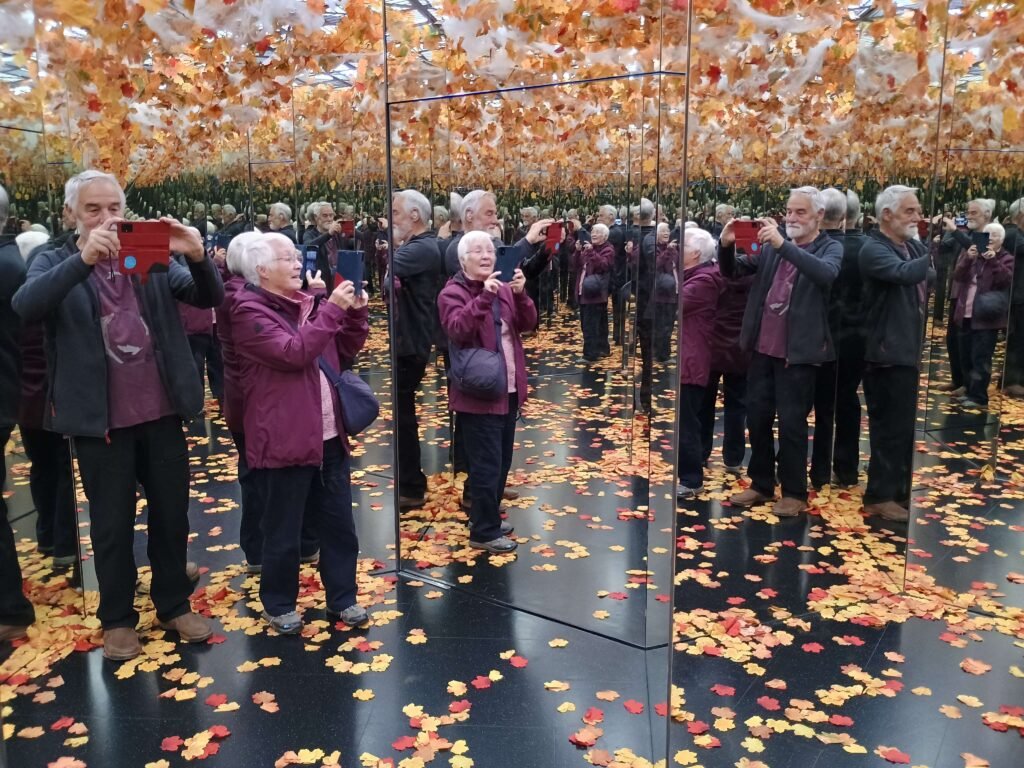
Our last port of call was the Museum of Illusions. Something ‘other’ to say the least! So much fun that Jenni needed to lie down for a rest. another don’t miss experience.
We stayed in the latest type of hostel / budget accommodation: City Hub. Everyone has their hub / pod …. a sophisticated box to sleep in. You can even alter the colour(s) and intensity of the lighting on the app on phone!
What was good about our time in Copenhagen was that we felt closer to everyday life by wandering around, being on the buses and once on their great metro with spotless driverless trains where passengers can look out of big windows at the front and back.
We had a really good evening meal where there only seemed to be local people. It was home cooking served buffet style and you cleared your table. We are getting used to the transport… our breakfast cafe overlooked a busy junction. Bikes outnumbered cars… three lanes of traffic each way: pedestrians, cyclists and vehicles.
Bikes of every conceivable shape and size and not just restricted to one strata of society. If you look carefully you will see traffic lights for each group: pedestrians, cyclists and vehicles. It is well organised and disciplined.
So many things. so many blessings.
SCANDI 24 IN-DEPTH REFLECTIONS ON THIS OAP ADVENTURE!
Some believed that we were mad to take on this type of holiday at our age! Yes, it has been ‘challenging’ in many ways. There were a few moments when we thought: why are we doing this? OAPs embarking on the sort of thing that is normally done by teens or twenties? One son, even volunteered to rescue us if things went wrong! Ageism?
My head still can’t get round the totality of the experience: all that we saw and did, let alone all the thoughts and challenges these things provoked. However, we managed. The stumbling abilities of a couple with over 50 years of learning about how to blend each other’s strengths and weaknesses to good effect, actually paid off! It would be possible, but much harder for a solo traveller. Jenni got a free rail pass as my carer – she did brilliantly. With moderate to severe hearing loss, I have usually no idea what all the announcements are about.
Several themes have jostled for prominence in concluding the Scandi 24 story. Titles such as “Scope for Adventure” or “Can You Take It?” came to mind in summing up this type of ‘holiday’.
SEVERAL POINTS ABOUT THE NATURE OF THIS TYPE OF HOLIDAY.
THINGS DO GO WRONG
For example, I began writing this during the worst experience of our three weeks! We had decided to take the final journey home in one marathon 24 hour stint. In hindsight not a wise decision. This included a lengthy, middle of the night, stop in Cologne Station. We can now advise you not to do this , unless you want the company of police and a lot of very sad people. To cap it all, at the last minute, we discovered that our first train of the new day was cancelled.
Following a long detour to the Netherlands, we got to Brussels after our Eurostar had left for London. If I had not been wearing my Sunflower Lanyard which sometimes gets me special assistance, I think we would have stayed there over night. Deep thanks to Eric and Dora who picked us up late in the evening at Chester to get us home more than thirty hours after we left Copenhagen. Can you take it when things go wrong?! Anyway, what’s the risk: an extra night somewhere is not going to kill.
EVERYTHING IS DIGITAL
Whilst younger people will fail to understand the problem, this is a challenge for our generation. Imagine walking out of a station in a city you’ve never seen before and trying to get to an incomprehensibly named address which is too far to walk to carrying luggage. After getting the public transport directions on Google Maps, you need a ticket. There is no other way to get one than to download the relevant App, guess the zones you want to travel in and buy your digital ticket which is a QR code on your phone. You pay by card and so your bank requires authentication. Then all that’s left to do is work out whether you are catching the bus going left or right and which side of the road it is on. All that is not necessarily as obvious as it may seem in an unknown city. Are you adventurous?!
GOING BY RAIL IS A DIFFERENT MINDSET
Going by rail gives depth to the experience: a stronger connection with the landscapes you pass through. Unlike planes, trains go to the centre of cities. So, despite the sting in the tail, rail gets a strong vote. On Interrail, the relatively cheap option of travelling first class is brilliant.
THE HOSTELS
Apart from the first, which got our booking wrong, the hostels worked well for us and we would use them again. Eating out can be incredibly expensive, so the hostels enabled us to slash our food costs with very little effort. This meant we were able to spend more on doing and seeing the things that make a holiday special.
THE REWARDS
The challenges and the negatives were heavily outweighed by the rewards of independent travel which are immense. The choices we made enhanced the richness and diversity of our many experiences. We saw and absorbed so much: our heads are full! Obviously, the drama of the geography of Southwest Norway is something we will never forget. While we were there the weather was marvellous, so much so that the fjords that usually have so many waterfalls were unusually dry.
This experience was one of many that touched on the challenge of climate change. On return, I was astonished at what was still growing in the garden. Forty years ago, it would have been impossible for outdoor tomatoes, runner beans and sweet peas to be growing towards the end of the first week of October. The grass was growing as though it was May. Scandinavia is generally ahead of us: renewable energy, use of electric cars, restraining cruise ships, etc. Much to reflect on.
CONCLUSIONS
- We would recommend this. We have been exposed to all sorts of scenery, history, culture and art in four countries. We have enjoyed a lot of impressive architecture.
- We were taken out of the inherent smallness of our rural OAP life. This in itself relates to the themes of this website. I’m constantly reminded of the issues raised by Rebecca Solnit and discussed on the ‘Travel Thoughts’ Page. This holiday was ’out of the box’
Whilst it is important for many who live busy stressful lives to enjoy a holiday that is just another box, one that is about escape, being pampered and just relaxing, that is not the case for most retired people. Inter-railing and Hostelling provided a wealth of “out of the box” experiences: chances to live in the whole world rather than interiors we have built up against it. Being out of the box was perhaps the key element of this holiday. It was enhanced by travelling outside the peak tourist time. There were a few places where we, as tourists, were in a small minority. Like the back street cafe where we had our last meal. It all helped us absorb the places we visited.
- Of all the countries, it was Denmark that left the deepest mark on me. Denmark is consistently ranked among the world’s happiest countries. Why? The experts tell us this is because of free university education and good health care, a high minimum wage, a good work-life balance, having safe environments and stunning landscapes with a high adoption of renewable energy sources.
Is there something more going on? Only recently have they relaxed Sunday trading restrictions. There are still a lot of shops closed on Sundays. To add a controversial observation: whilst only 5% attend church, over 70% identify with their CofE equivalent. They seem, as a nation, to be closer to original Christian values than perhaps we are in our multi-cultural post-Christian society in the UK. The city atmosphere was different: gentler and less driven. If I had to live in a city I would vote for Aarhus.
I was impressed by the bikes. In city centres it seemed there were more bikes than cars. At junctions there were normally three sets of traffic lights: one each for pedestrians, cyclists and vehicles. See the lights in this picture:
They were extraordinarily disciplined. Even if the road was clear, with very few exceptions pedestrians always obeyed the lights.
Maybe it was all the cycling they do but we did not see many, if any, obese Danes. Perhaps cycling like walking is a more ‘out of the box’ activity in itself and has its own social implications.
ONE-OFFS
Scandinavian eggs are white. Ours are brown. Why?
Neither of us recollects seeing a pothole in Denmark.
There were an extraordinary number of naked ladies around – statues.
